Roberto Gastone Zeffiro Rossellini, 8 May 1906 – 3 June 1977, was an Italian film director, producer and screenwriter. He was one of the most prominent directors of the Italian neorealist cinema.
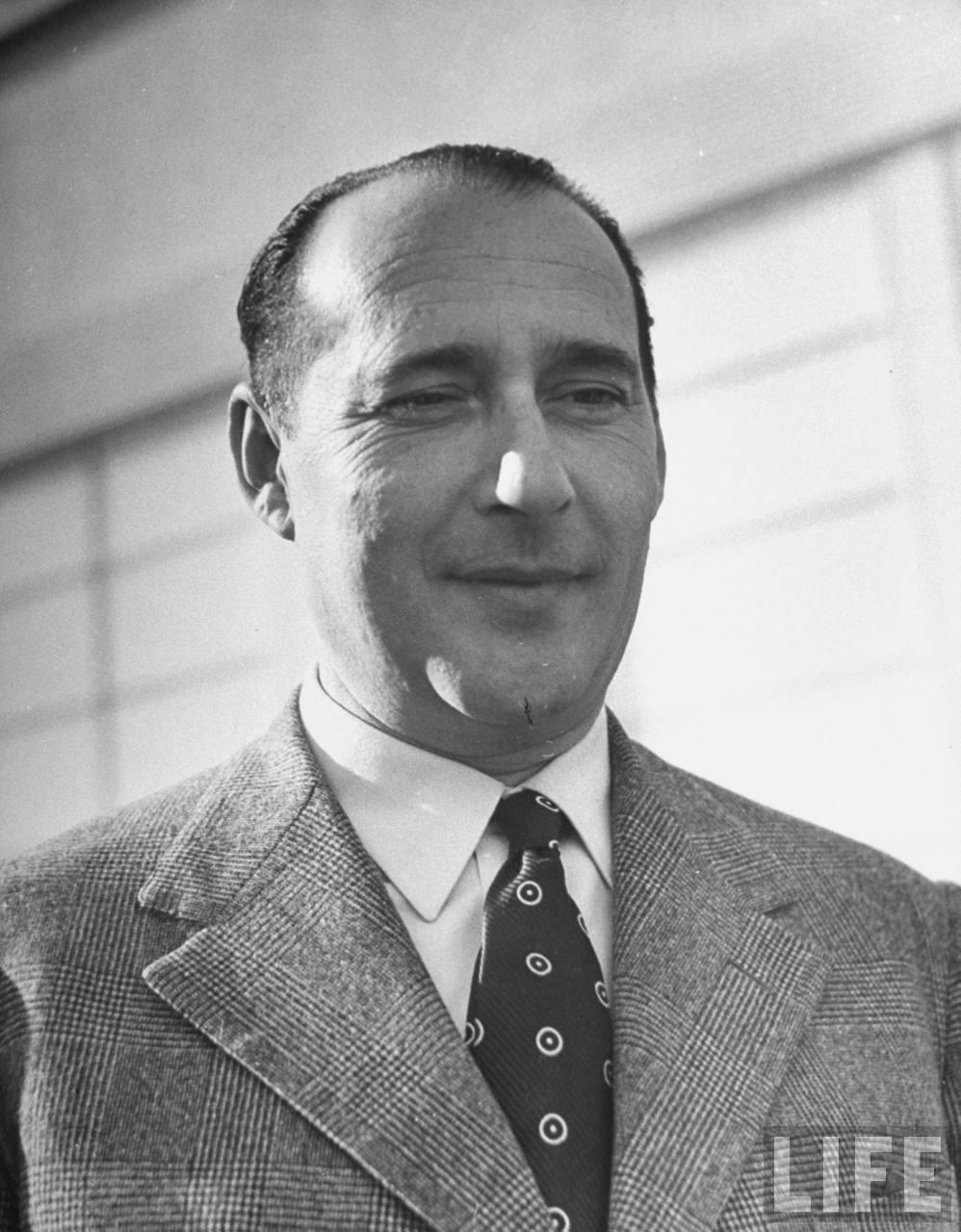
Rossellini was born in Rome. His mother, Elettra (née Bellan), was a housewife born in Rovigo, Veneto and his father, Angiolo Giuseppe "Peppino" Rossellini, who owned a construction firm, was born in Rome from a family originally from Pisa, Tuscany. His mother was of partial French descent, from immigrants who had arrived in Italy during the Napoleonic Wars. He lived on the Via Ludovisi, where Benito Mussolini had his first Roman hotel in 1922 when Fascism obtained power in Italy.
Rossellini's father built the first cinema in Rome, the "Barberini", a theater where movies could be projected, granting his son an unlimited free pass; the young Rossellini started frequenting the cinema at an early age. When his father died, he worked as a soundmaker for films and, for a certain time, he experienced all the ancillary jobs related to the creation of a film, gaining competence in each field. Roberto had a younger brother, Renzo, who later scored many of his films.
Although he wasn't personally religious, he had a strong interest in Christian values in the contemporary world; he appreciated Catholic ethics and religious sentiment — things which he saw as being neglected in the materialist world.
In 1937, Rossellini made his first documentary, Prélude à l'après-midi d'un faune. After this essay, he was called to assist Goffredo Alessandrini in making Luciano Serra pilota, one of the most successful Italian films of the first half of the 20th century. In 1940 he was called to assist Francesco De Robertis on Uomini sul fondo. His close friendship with Vittorio Mussolini, son of Il Duce, has been interpreted as a possible reason for having been preferred to other apprentices.
Some authors describe the first part of his career as a sequence of trilogies. His first feature film, The white ship (1941), was sponsored by the audiovisual propaganda centre of Navy Department and is the first work in Rossellini's "Fascist trilogy", together with A pilot returns (1942) and The man with a cross (1943). To this period belongs his friendship and cooperation with Federico Fellini and Aldo Fabrizi. The Fascist regime collapsed in 1943 and, just two months after the liberation of Rome (4 June 1944), Rossellini was preparing the anti-fascist Roma città aperta (Rome open city, 1945). Fellini assisted on the script and Fabrizi played the role of the priest, while Rossellini self-produced. Most of the money came from credits and loans and film had to be found on the black market. This dramatic film was an immediate success. Rossellini had started now his so-called Neorealistic trilogy, the second title of which was Paisà (1946), produced with non-professional actors and the third, Germany year zero (1948), sponsored by a French producer and filmed in Berlin's French sector. In Berlin also, Rossellini preferred non-actors, but he was unable to find a face he found "interesting"; he placed his camera in the center of a town square, as he did for Paisà, but was surprised when nobody came to watch.
As he declared in an interview "in order to really create the character that one has in mind, it is necessary for the director to engage in a battle with his actor which usually ends with submitting to the actor's wish. Since I do not have the desire to waste my energy in a battle like this, I only use professional actors occasionally". One of the reasons for success is supposed to be Rossellini's rewriting of the scripts according to the non-professional actors' feelings and histories. Regional accent, dialect and costumes were shown in the film as they were in real life.
After his Neorealist trilogy, Rossellini produced two films now classified as the 'Transitional films': L'amore (1948) (with Anna Magnani) and La macchina ammazzacattivi (1952), on the capability of cinema to portray reality and truth (with recalls of la commedia dell'arte).
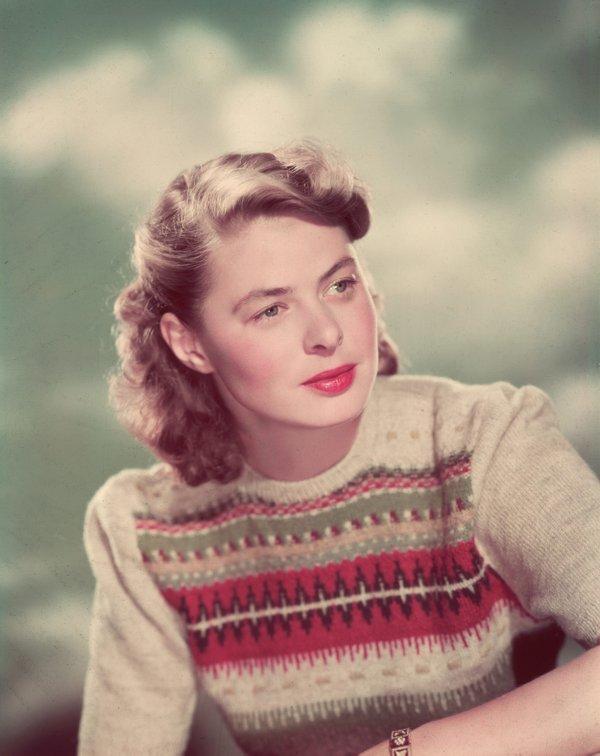
Ingrid Bergman in 1945.
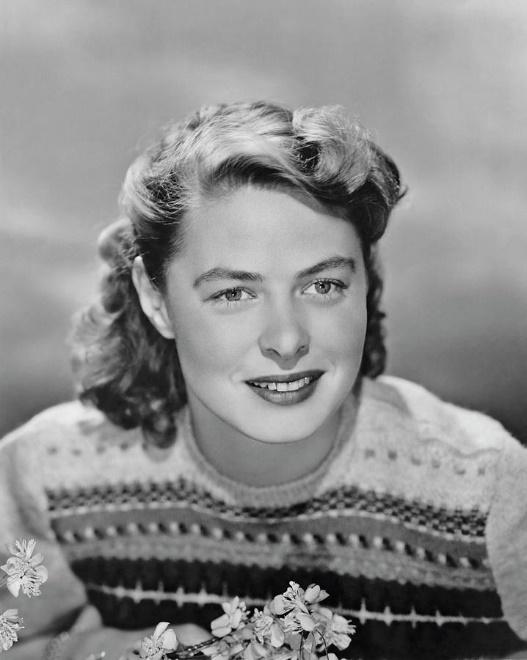
Ingrid Bergman.
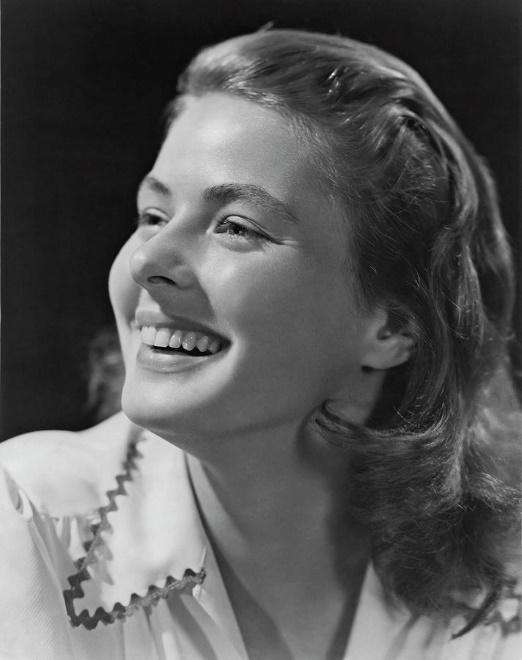
Publicity still of Swedish actress Ingrid Bergman who is to appear in RKO Radio's 'After the storm' in 1945. Photo by Archive Photos/Getty Images.
In 1948, Rossellini received a letter from a famous foreign actress proposing a collaboration: “dear Mr. Rossellini, I saw your films Open city and Paisan and enjoyed them very much. If you need a Swedish actress who speaks English very well, who has not forgotten her German, who is not very understandable in French and who in Italian knows only "ti amo," I am ready to come and make a film with you”. Ingrid Bergman.
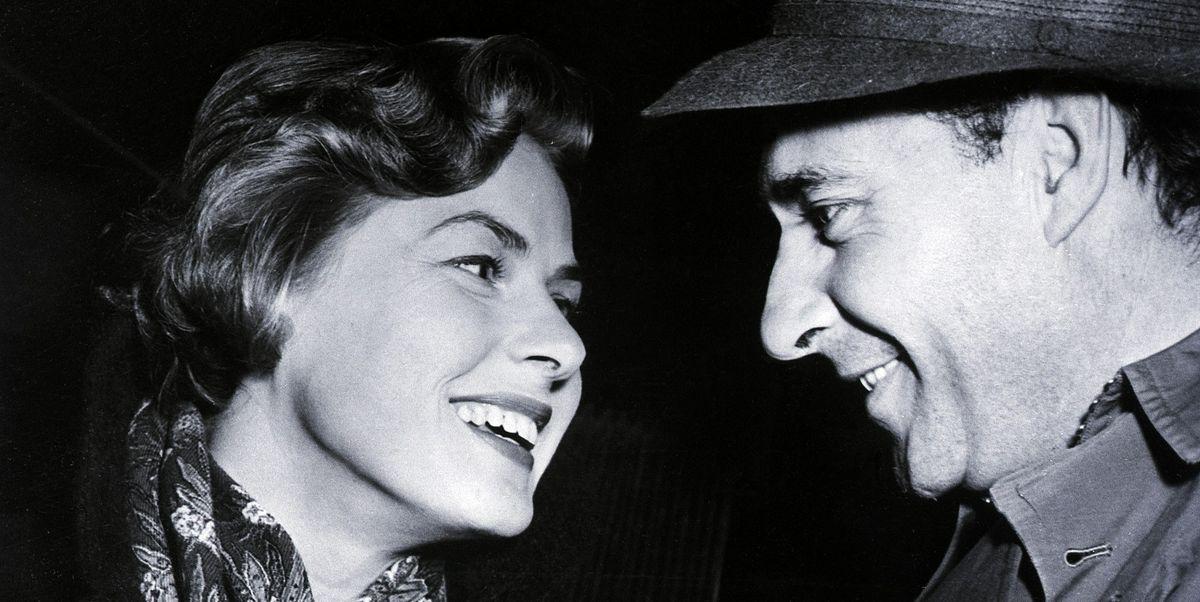
Ingrid Bergman and Roberto Rossellini.
With this letter began one of the best known love stories in film history, with Bergman and Rossellini both at the peak of their careers.
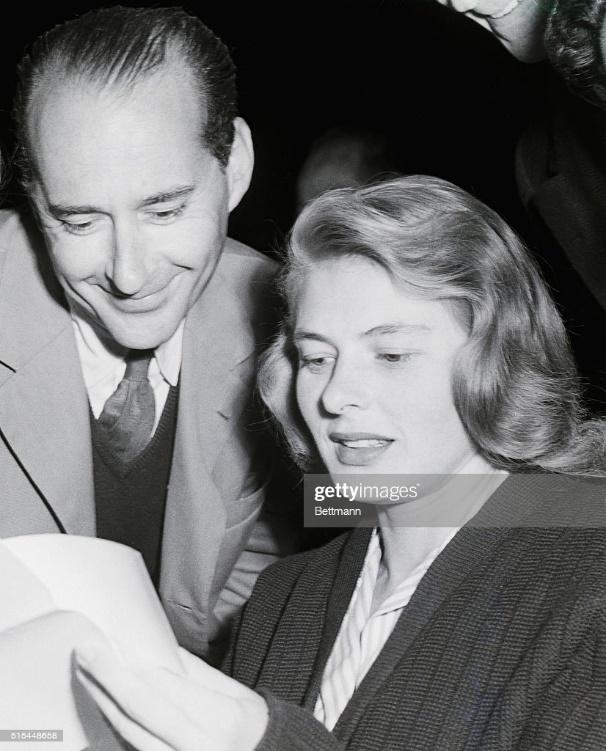
August 14, 1949. Ingrid Bergman and director Roberto Rossellini read over the script for the film Stromboli before shooting a scene. This is the first photograph of the couple since Ingrid Bergman announced plans to divorce her husband. Credit: Bettmann / Contributor.
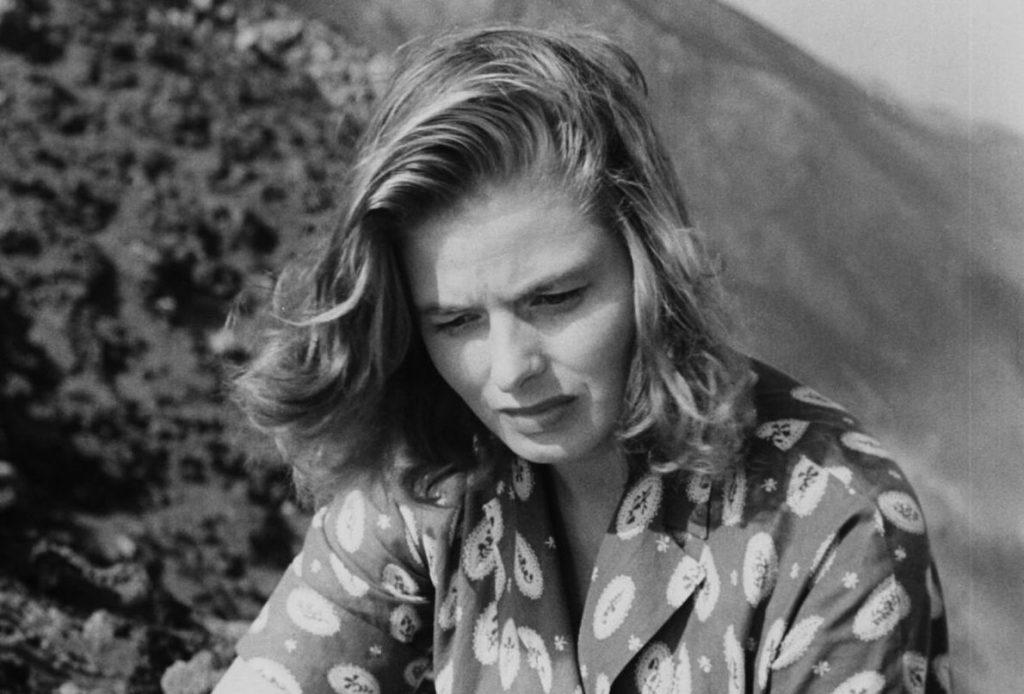
Ingrid Bergman on the set of “Stromboli, terra di Dio”.
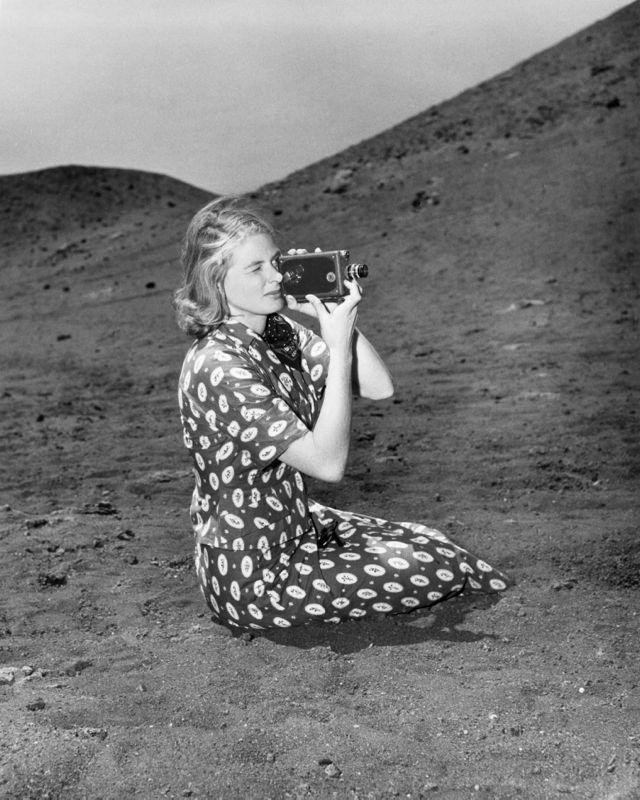
Ingrid Bergman on the set of “Stromboli, terra di Dio”.
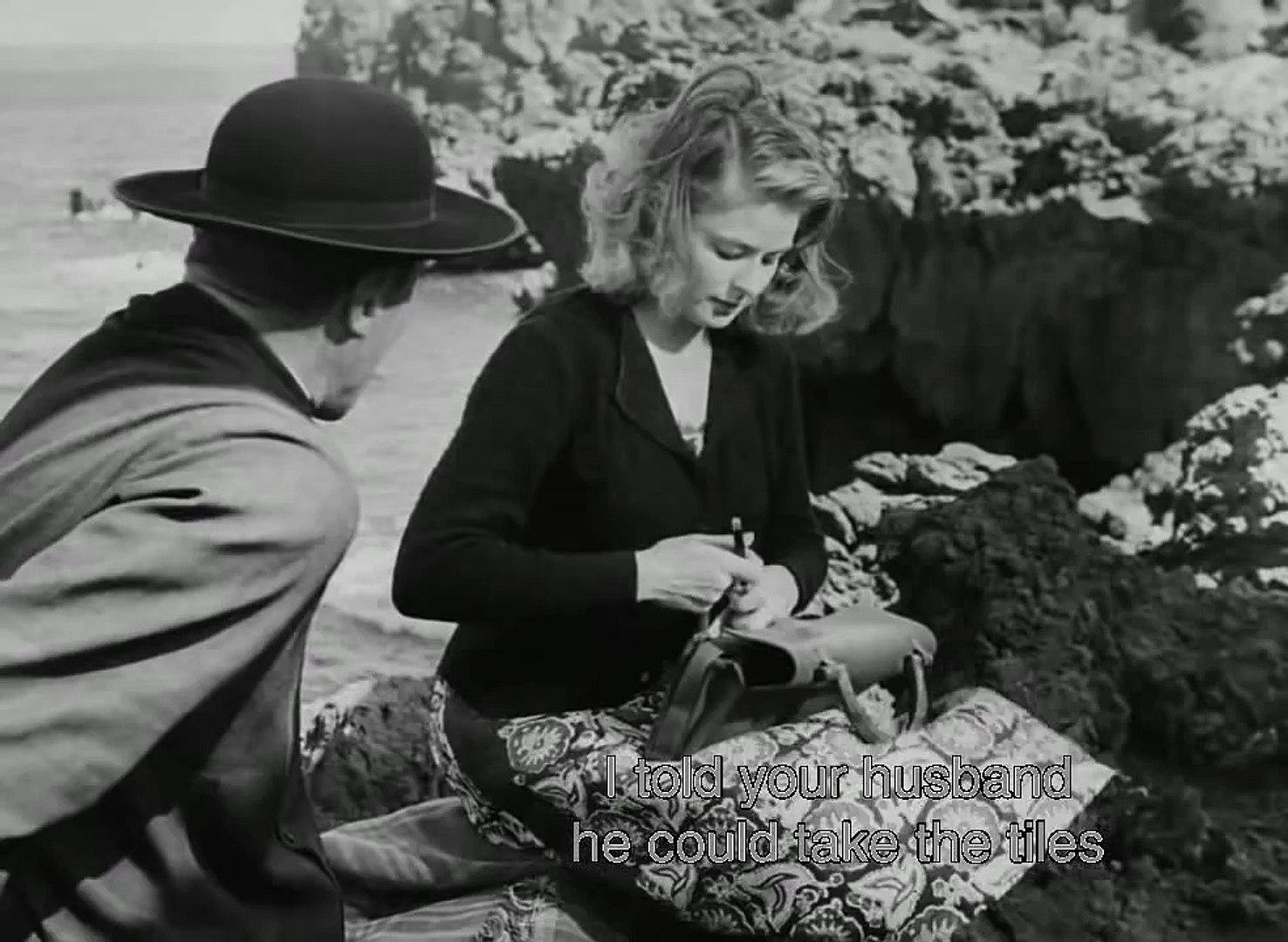
Ingrid Bergman in Stromboli in 1950 starring in Rossellini’s movie.
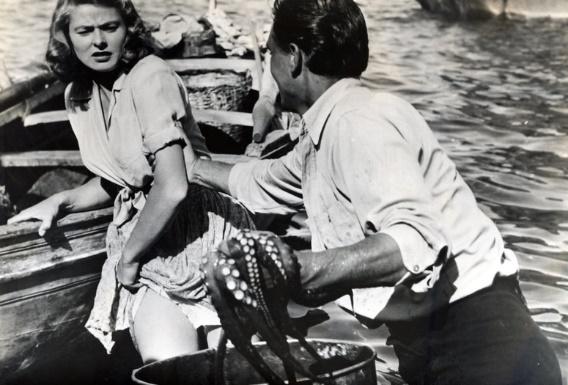
Ingrid Bergman in Stromboli. Photographer: United Archives.
Their first collaboration was Stromboli terra di Dio (1950) (in the island of Stromboli and its volcano quite conveniently erupted during filming).
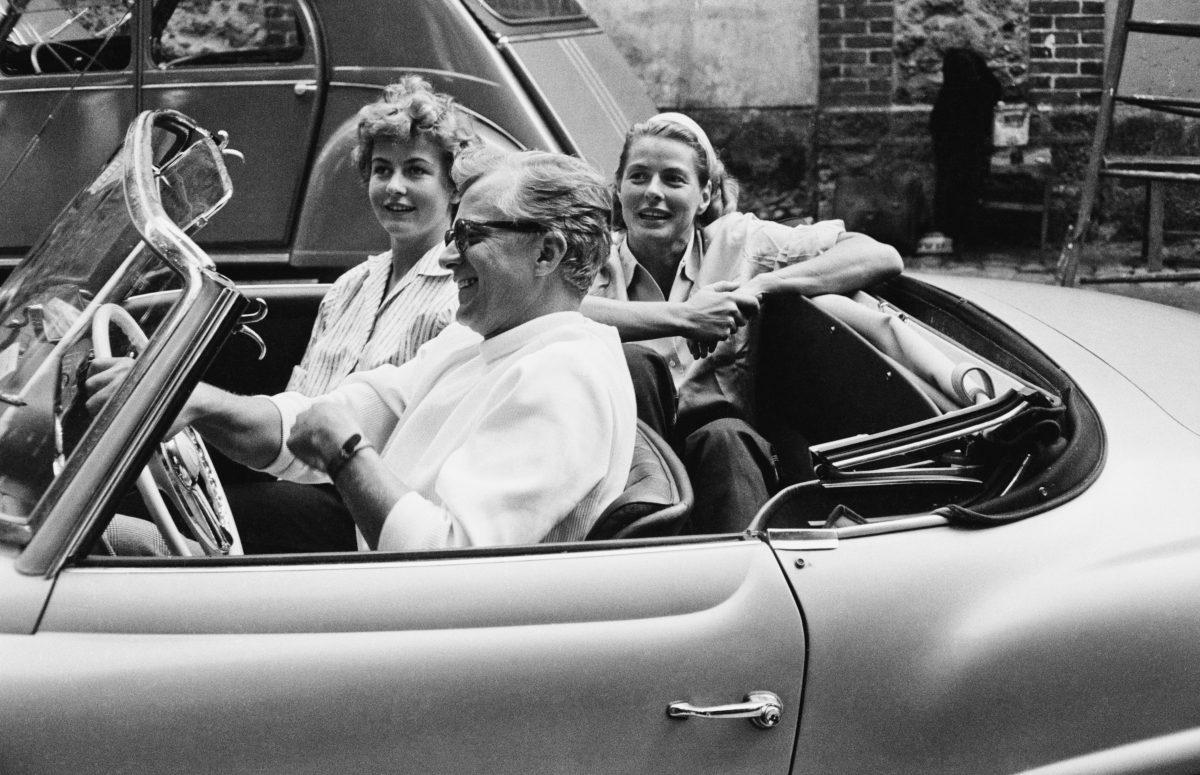
Ingrid Bergman.
This affair caused a great scandal in some countries (Bergman and Rossellini were married to other people);

August 26, 1950, Venice, Italy. From a balcony of the Grand Hotel, Ingrid Bergman and Roberto Rossellini look at the world go by, that part of the world that travels on the Grand Canal of Venice, during their recent visit to the resort. Image provided by Getty Images.
The scandal intensified when Bergman became pregnant with Renato Roberto Ranaldo Giusto Giuseppe ("Robin") Rossellini. Rossellini and Bergman had two more children, Isabella Rossellini (actress & model) and her twin, Ingrid Isotta.
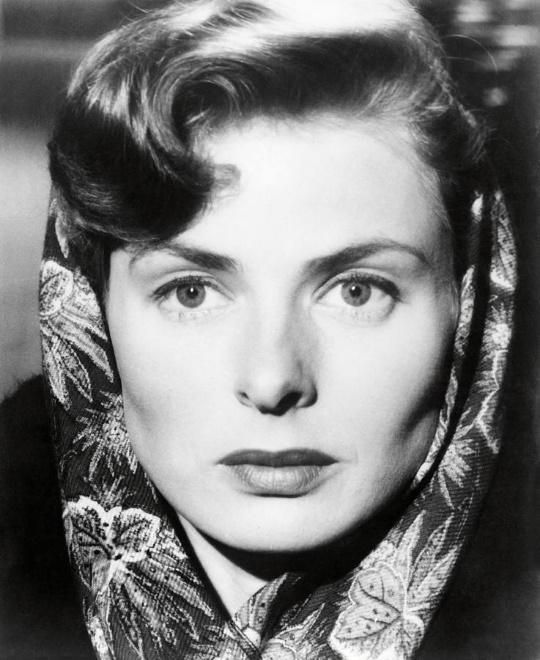
Ingrid Bergman in The greatest love, 1952 (original title Europa ’51).
Europa '51 (1952), Siamo donne (1953), Journey to Italy (1954), La paura (1954) and Giovanna d'Arco al rogo (1954) were the other films on which they worked together.
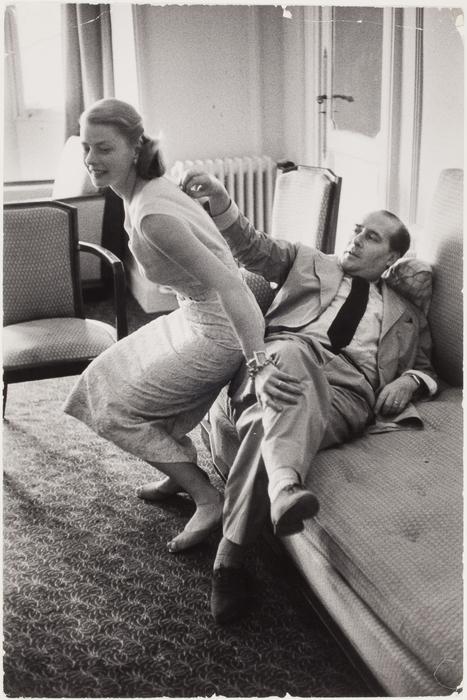
Ingrid Bergman and Roberto Rossellini in Cannes in 1956. Credit: Ben Shneiderman Collection.
In 1957, Jawaharlal Nehru, the prime minister of India at the time, invited him to India to make the documentary India and put some life into the floundering Indian Films Division. Though married to Bergman, he had an affair with Sonali Senroy Das Gupta, a screenwriter, herself married to local filmmaker Hari Sadhan Das Gupta, who was helping develop vignettes for the film. Given the climate of the 1950s, this led to a huge scandal in India as well as in Hollywood. Nehru had to ask Rossellini to leave. Soon after, Bergman and Rossellini separated.
In 1971, Rice University in Houston, Texas, invited Rossellini to help establish a Media Center, where in 1970 he had begun planning a film on science with Rice professor Donald D. Clayton. They worked daily for two weeks in Rome in summer 1970, but financing was insufficient for filming to begin. In 1973, he was invited to teach at Yale University in New Haven, Connecticut, where he taught a one-semester course titled "The Essential Image."
Rossellini's final project was the documentary Beaubourg, filmed in 1977 and first premiered in 1983.
In 1934, Rossellini married Assia Noris, a Russian actress who worked in Italian films; the marriage was annulled in 1936. On 26 September 1936, he married Marcella De Marchis (17 January 1916, Rome – 25 February 2009, Sarteano), a costume designer with whom he collaborated even after their marriage was over. De Marchis and Rossellini had two sons: Marco Romano (born 3 July 1937 and died of appendicitis in 1946) and Renzo (born 24 August 1941). Rossellini and De Marchis divorced in 1950.
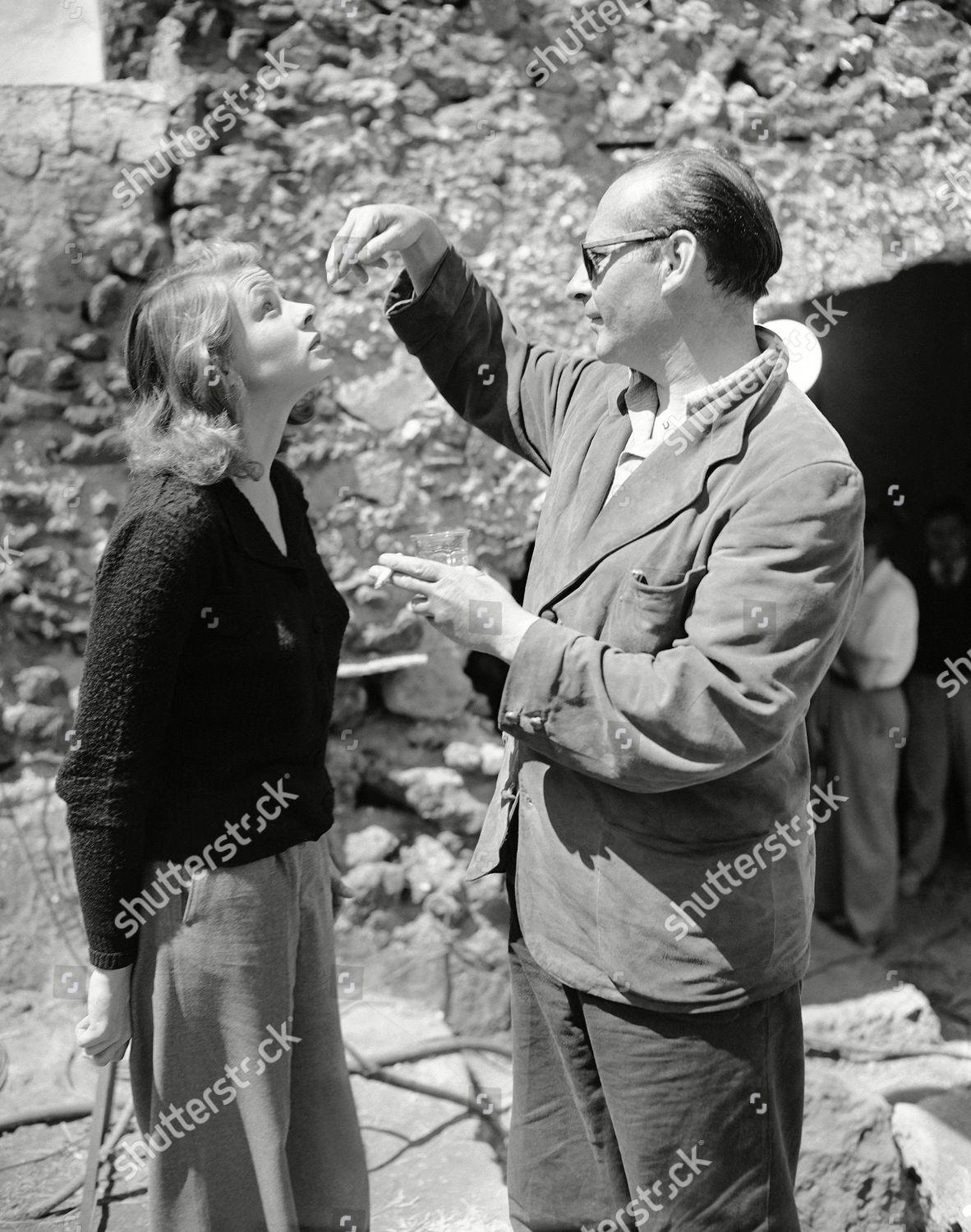
Roberto Rossellini and Ingrid Bergman in Italy. Shutterstock editorial.
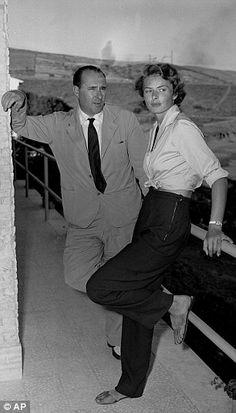
Roberto Rossellini with Ingrid Bergman.
While filming Stromboli, Rossellini had an affair with Ingrid Bergman (who was at the time married to Petter Lindström) in 1949. In the same month the film was released, Bergman gave birth to a boy, Renato Roberto Ranaldo Giusto Giuseppe ("Robin") Rossellini (born 2 February 1950). A week after her son was born, Bergman divorced Lindström and married Rossellini in Mexico. On 18 June 1952, she gave birth to the twin daughters Isotta Ingrid Rossellini and Isabella Rossellini.
In 1957, Rossellini had an affair with Bengali screenwriter Sonali Das Gupta (née Senroy) and soon after, Bergman and Rossellini separated. Rossellini eloped with Das Gupta in 1957 when she was 27 years old. He adopted her young son Arjun, renamed Gil Rossellini (23 October 1956 – 3 October 2010), who became a New York-based film producer. Rossellini and Das Gupta had a daughter together, Raffaella Rossellini (born 1958), who is an actress and model.
In 1973, Rossellini left Das Gupta for producer Silvia D'Amico Bendicò, but he remained married to Das Gupta until his death of a heart attack at age 71 in 1977.
Rossellini's films after his early Neo-Realist films — particularly his films with Ingrid Bergman — were commercially unsuccessful, though Journey to Italy is well regarded in some quarters. He was an acknowledged master for the critics of Cahiers du Cinema in general and André Bazin, François Truffaut and Jean-Luc Godard in particular. Truffaut noted in his 1963 essay, Roberto Rossellini prefers real life (available in The films in my life), that Rossellini's influence in France, particularly among the directors who became part of the nouvelle vague, was so great that he was in every sense "the father of the French New Wave".
His posthumous ex-son-in-law Martin Scorsese has acknowledged Rossellini's seminal influence in his documentary My voyage to Italy (the title itself a take on Rossellini's voyage to Italy). An important point to note is that, out of Scorsese's selection of Italian films from a select group of directors (Federico Fellini, Luchino Visconti, Vittorio De Sica, Michelangelo Antonioni), Rossellini's films form at least half of the films discussed and analyzed, highlighting Rossellini's monumental role in Italian and world cinema. The films covered include his Neo-Realist films to his films with Ingrid Bergman as well as The flowers of St. Francis, a film about St. Francis of Assisi. Scorsese notes in his documentary that, in contrast to directors who often become more restrained and more conservative stylistically as their careers advance, Rossellini became more and more unconventional and was constantly experimenting with new styles and technical challenges. Scorsese particularly highlights the series of biographies Rossellini made in the 60s of historical figures and, although he does not discuss it in detail, singles out La Prise de pouvoir par Louis XIV for praise. Certain of Rossellini's film related material and personal papers are contained in the Wesleyan University Cinema Archives to which scholars and media experts from around the world may have full access. Rossellini's son Renzo is producing the Audiovisual Encyclopedia of History by Roberto Rossellini, a multi-media support containing all of Rossellini's works, interviews and other material from the Rossellini archive. The Encyclopedia for now exists in prototype form.
Ingrid Bergman: the Notorious Nordic beauty. The ultimate in nonchalant Nordic chic, we celebrate the style of actress Ingrid Bergman. November 07, 2013. Text by Mhairi Graham.
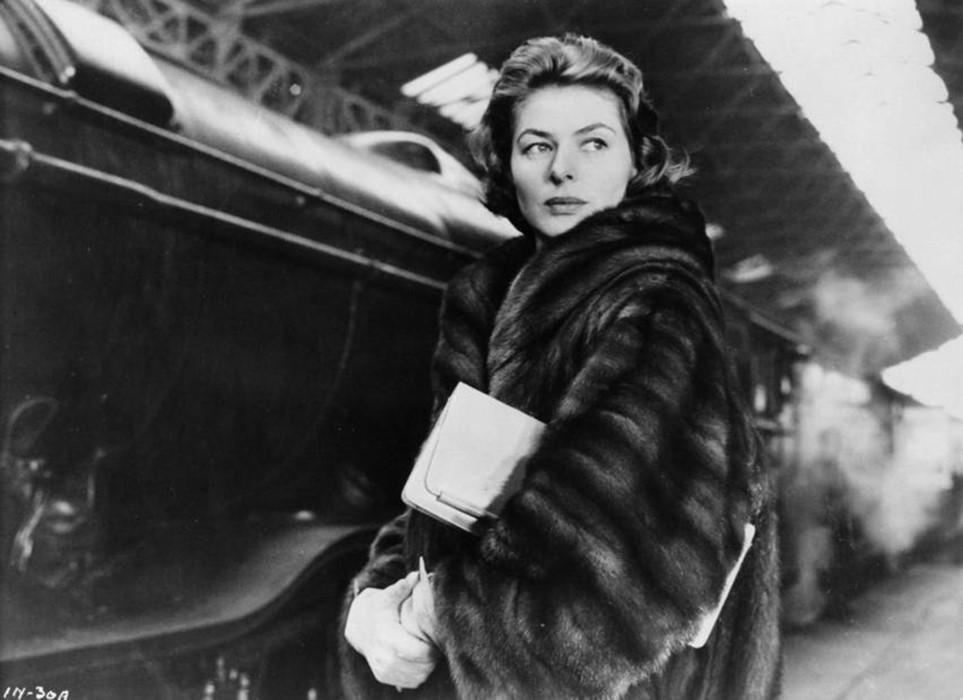
Ingrid Bergman in Indiscreet, 1958.
In 1946, Ingrid Bergman and Cary Grant embraced one another for what would become ‘the longest kiss in screen history’ in Hitchcock’s aptly named Notorious. Bergman was an icon of the 1940s, known for her natural beauty and individual style, labelled a ‘new brand of charm’ by LIFE Magazine.
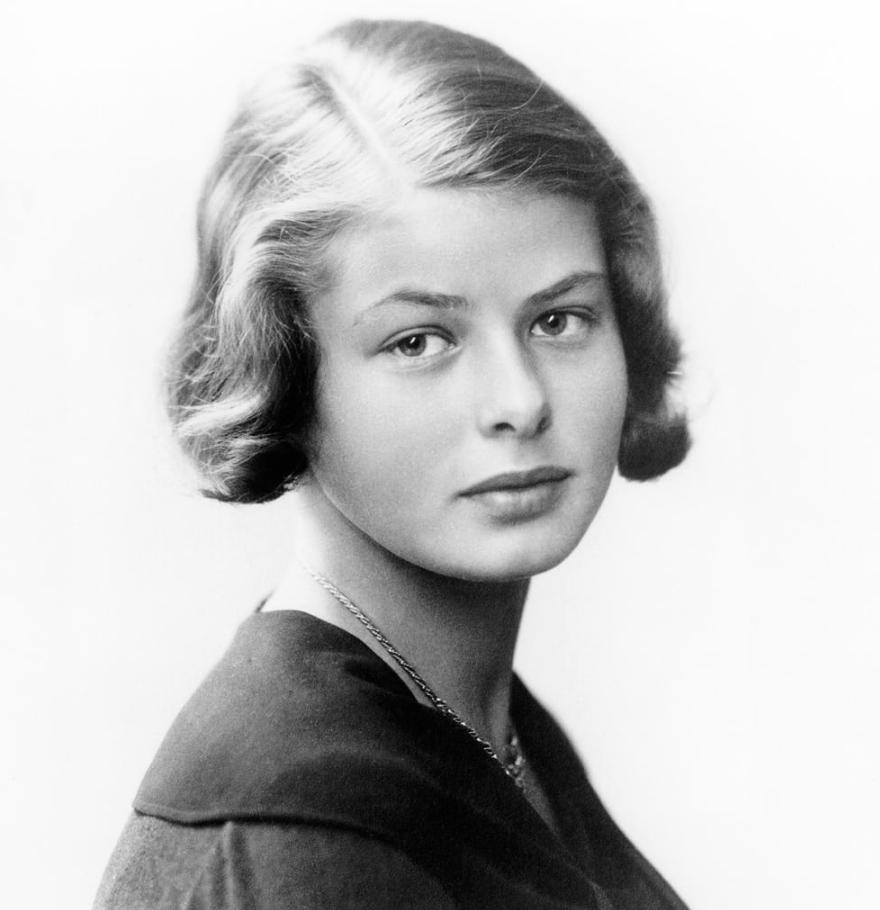
Bergman at around the age of 16. The self-portrait was taken with camera equipment inherited from her father.
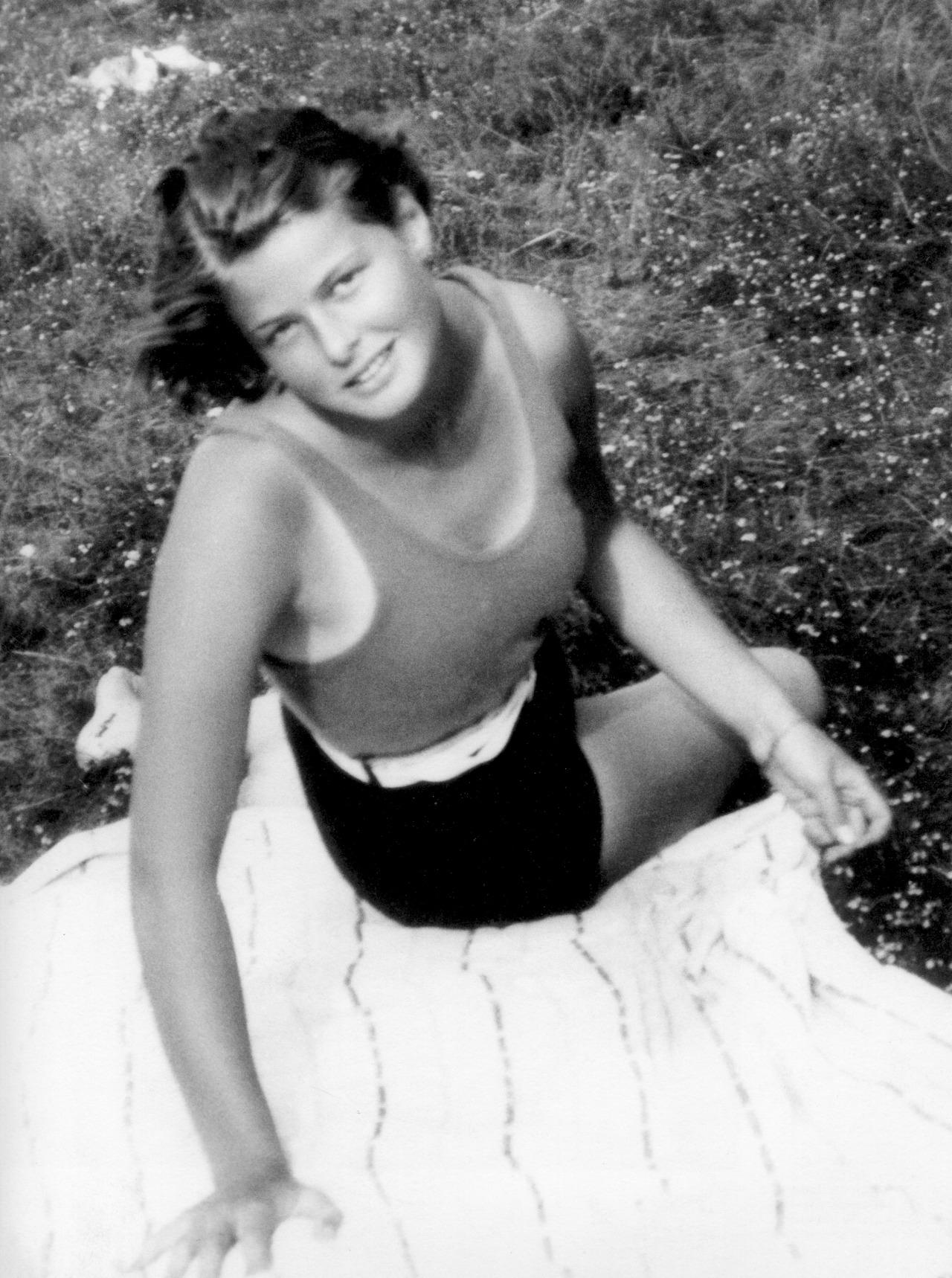
Ingrid Bergman, 1932.
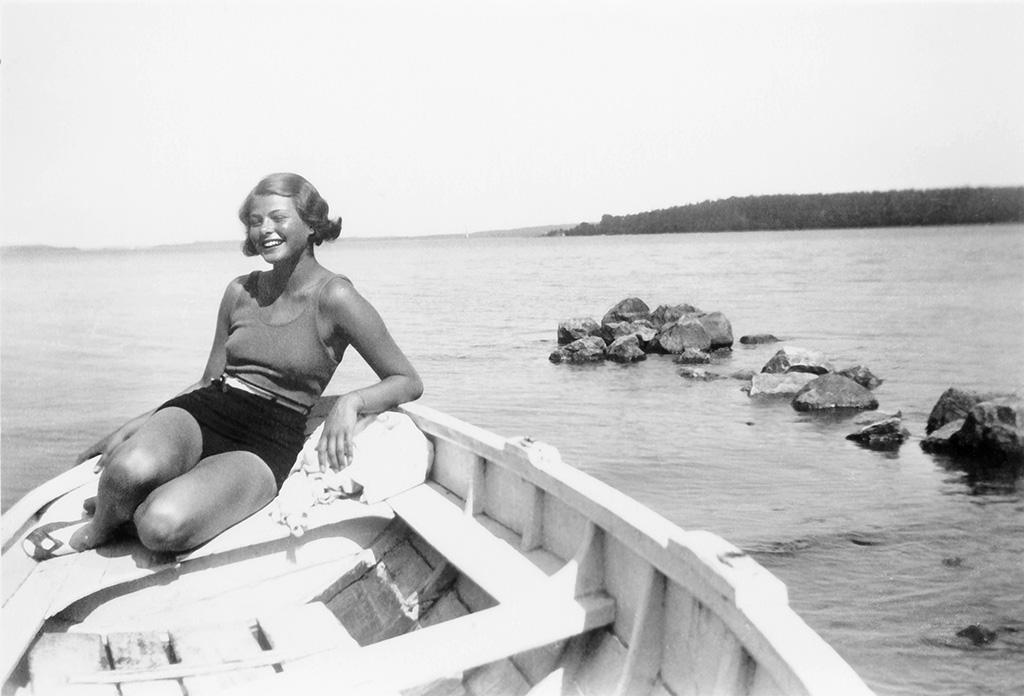
Ingrid Bergman sunbathing in a boat on Lake Mälaren in 1932.
Born in Sweden, she had an effortless aesthetic that was extremely unusual for the time, tempering her undeniable beauty with an androgynous edge, expressed through fitted suits and short curls. A Nordic beauty who wouldn't play pretty, she refused to pluck her eyebrows, cap her teeth or conform to the Hollywood glamour of the decade. She was an ideal fit for Dior’s New Look of 1947, in pencil skirts, brimmed hats and box jackets.
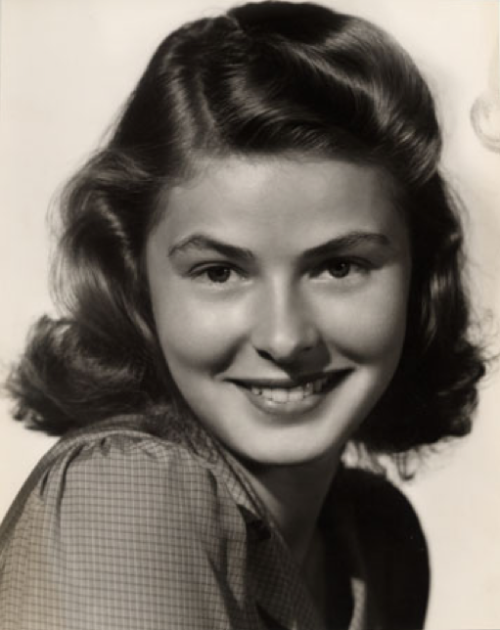
Ingrid Bergman, 1940s.
Bergman starred in 1942's Casablanca as Ilsa Lund, dressed in tailored white suits and statement headwear against the exotic background of Morocco. Multi-lingual, she performed in five languages and was known for her humble and easy-going attitude despite her stardom.
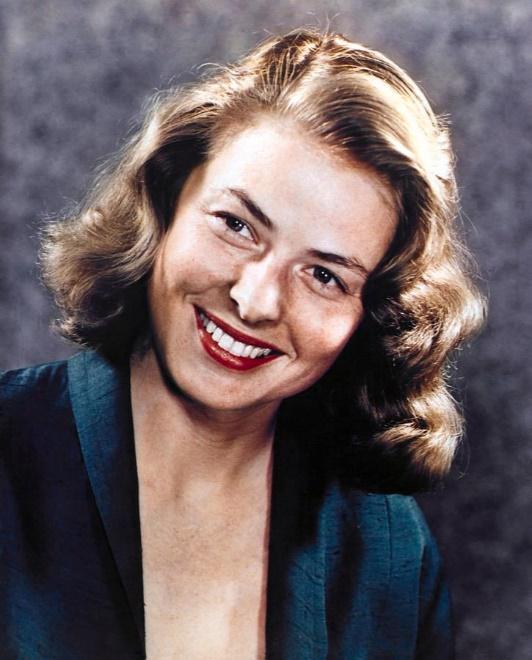
Ingrid Bergman in the 50s.
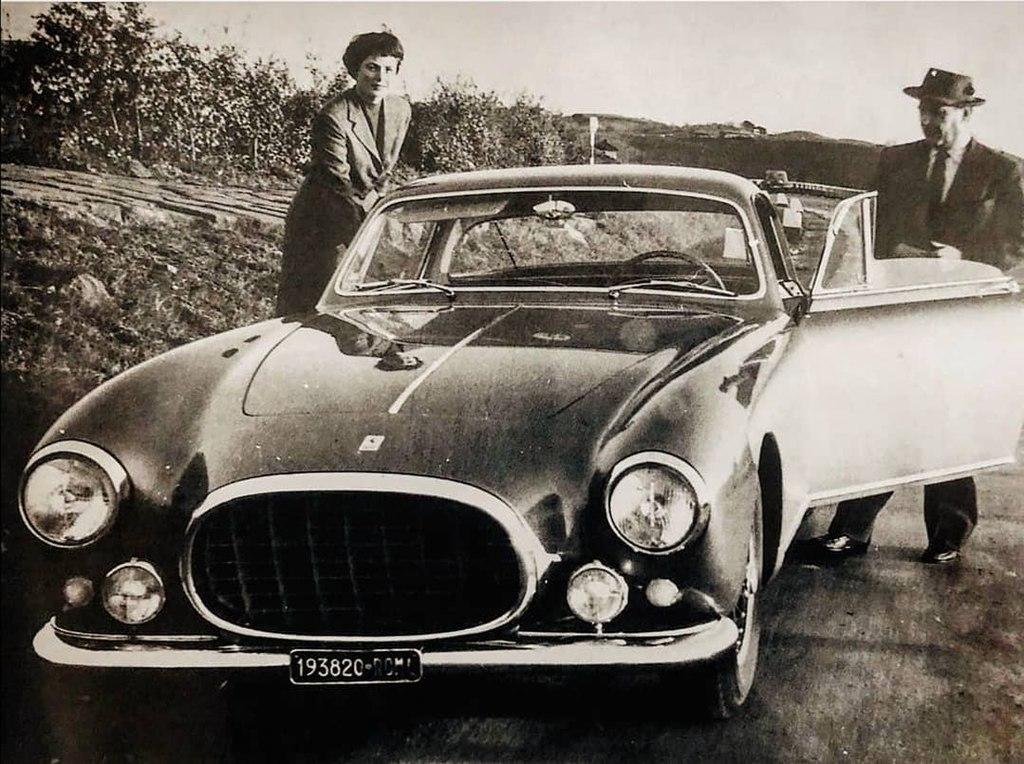
Movie stars Ingrid Bergman and husband Roberto Rossellini with the 1954 Ferrari 250 Europa Coupe Pinin Farina s/n 0299EU, license "193820 ROMA", which is where they lived. He was the first owner. Guessing this is in 1953 sometime.
She evoked controversy in 1950 when she famously left her husband for director Roberto Rossellini, with whom she fell pregnant.
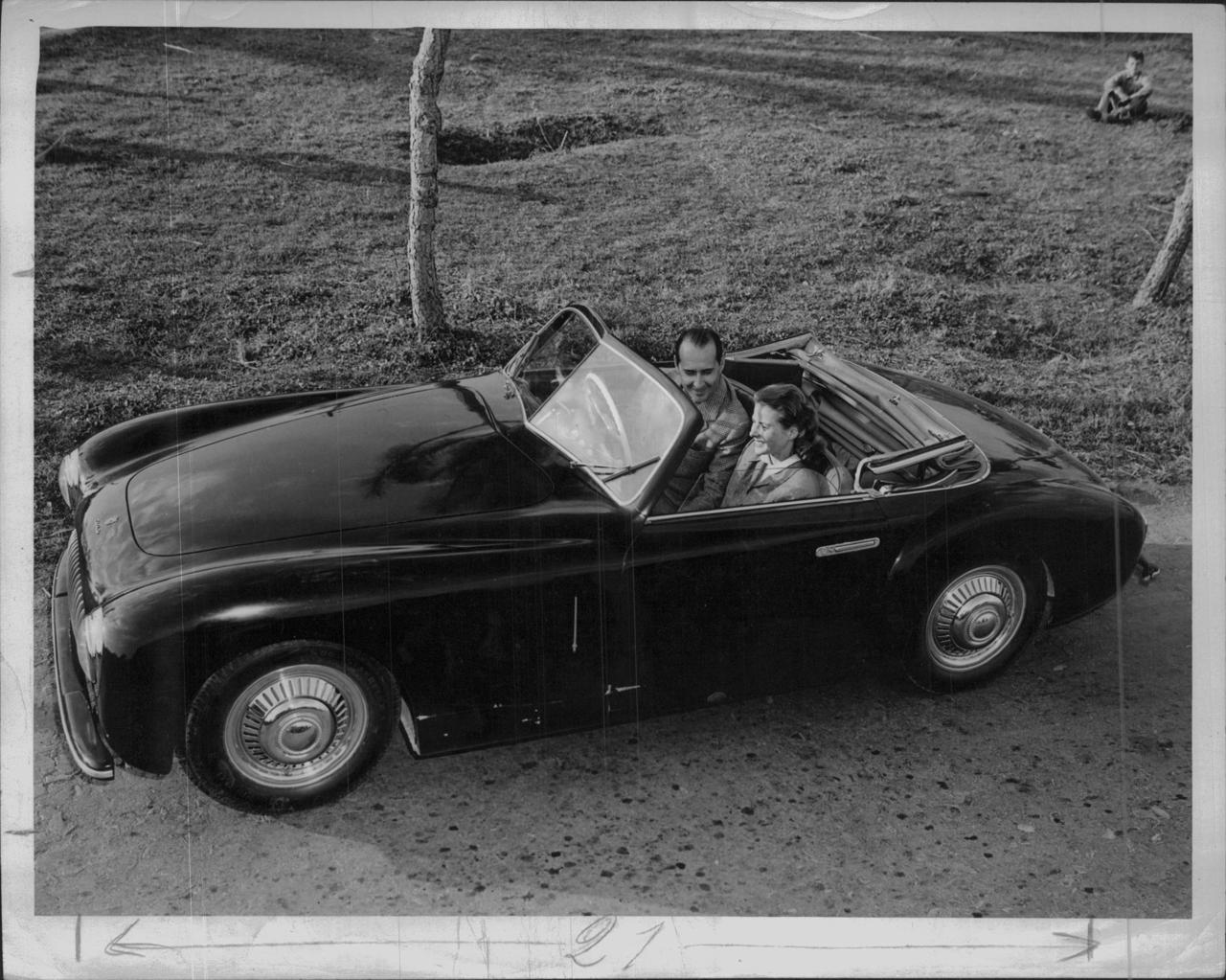
Ingrid Bergman and Roberto Rossellini in a Cisitalia spyder in 1953.
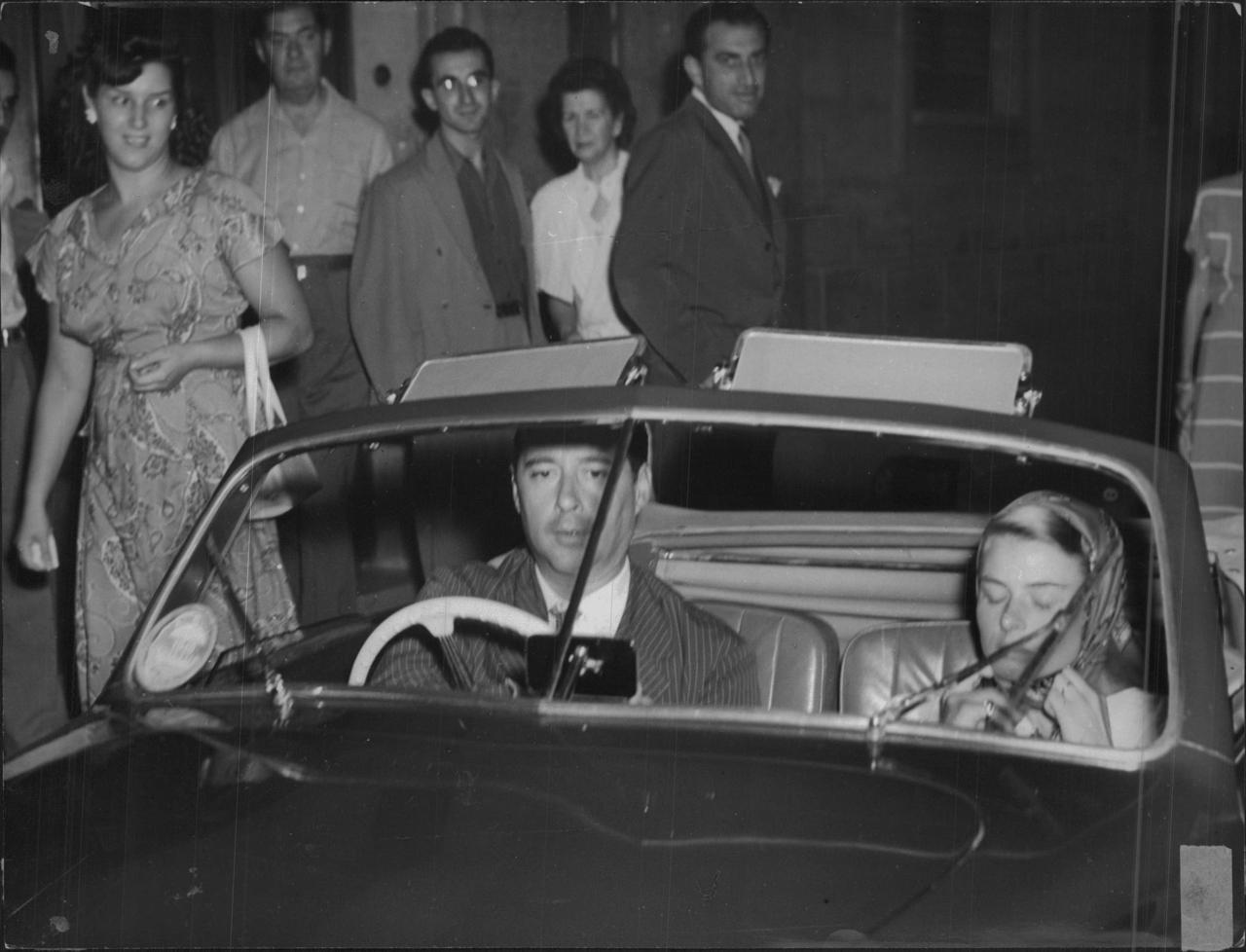
Ingrid Bergman and her husband Roberto Rossellini, always in a Cisitalia spyder in 1953.
The American public blew up at the scandal and she was denounced on the floor of the US Senate as an ‘instrument of evil’.
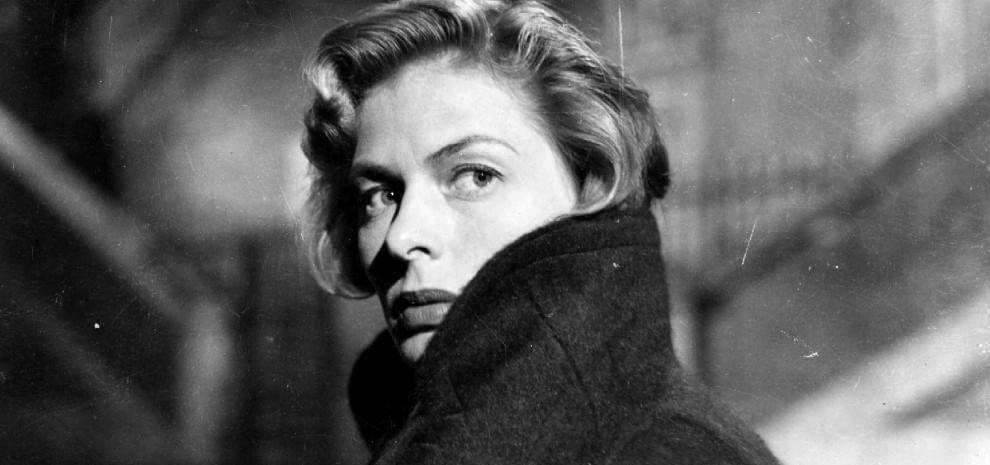
This somewhat shattered her onscreen purity, but she slowly won back the public and went on to win an Oscar in 1956 for her role in Anastasia and again in 1974's Midnight on the Orient Express. "I've gone from saint to whore and back to saint again, all in one lifetime,” she would say.
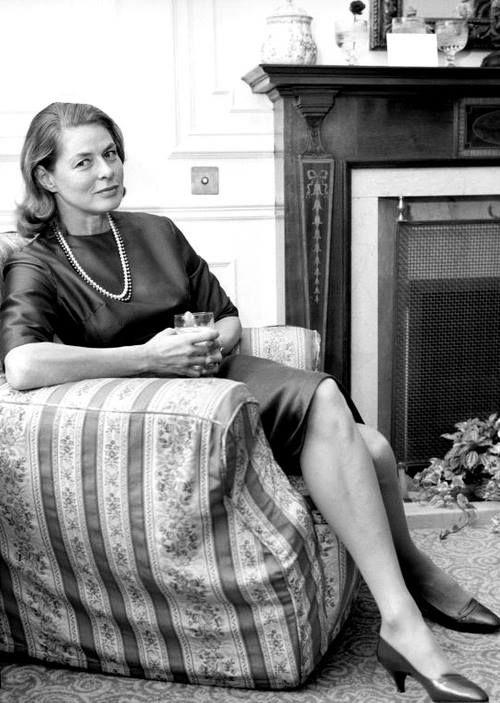
She was known for her appetite, eating crayfish with a bib on set as well as hot ice-cream sundaes.
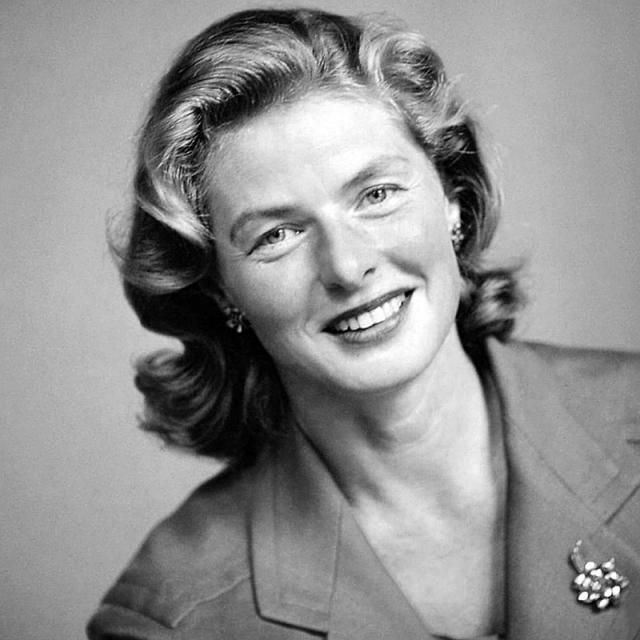
During filming, according to the director’s advice, her first husband would put a lock on their fridge, to prevent her from snacking.
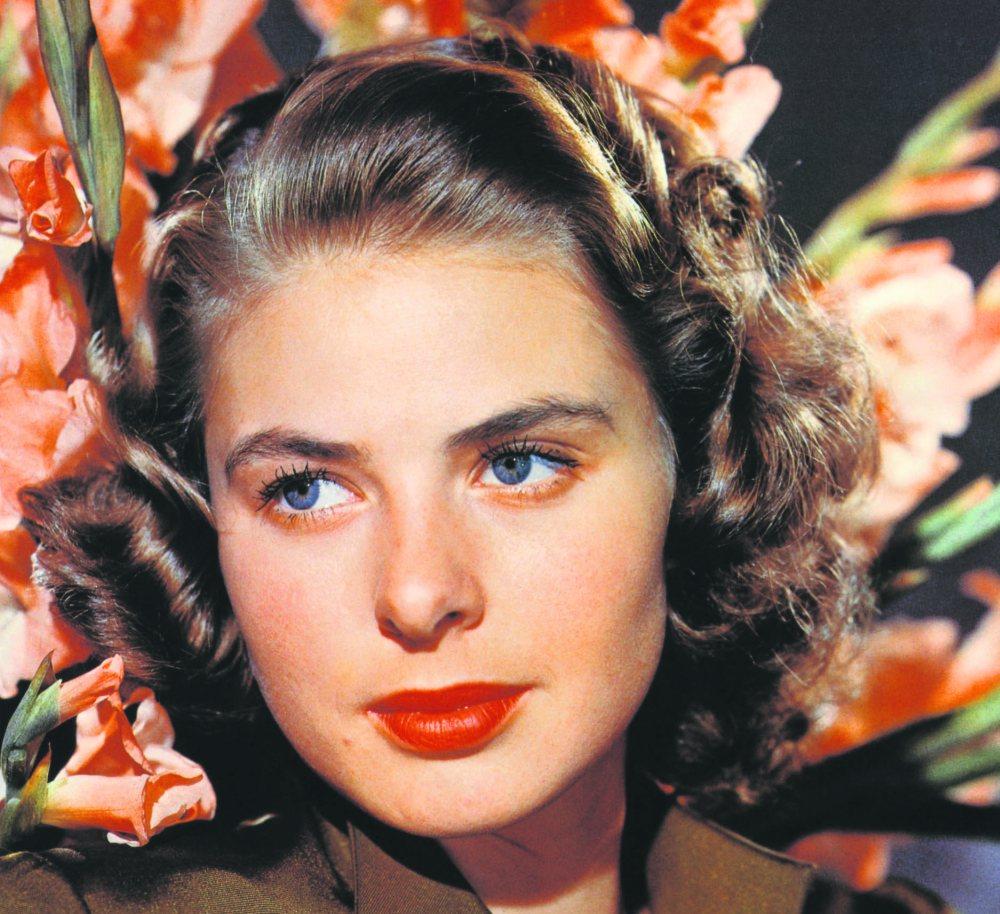
She was a charming combination of both sweet and stubbornly headstrong. “Be yourself,” she said, “the world worships the original.”
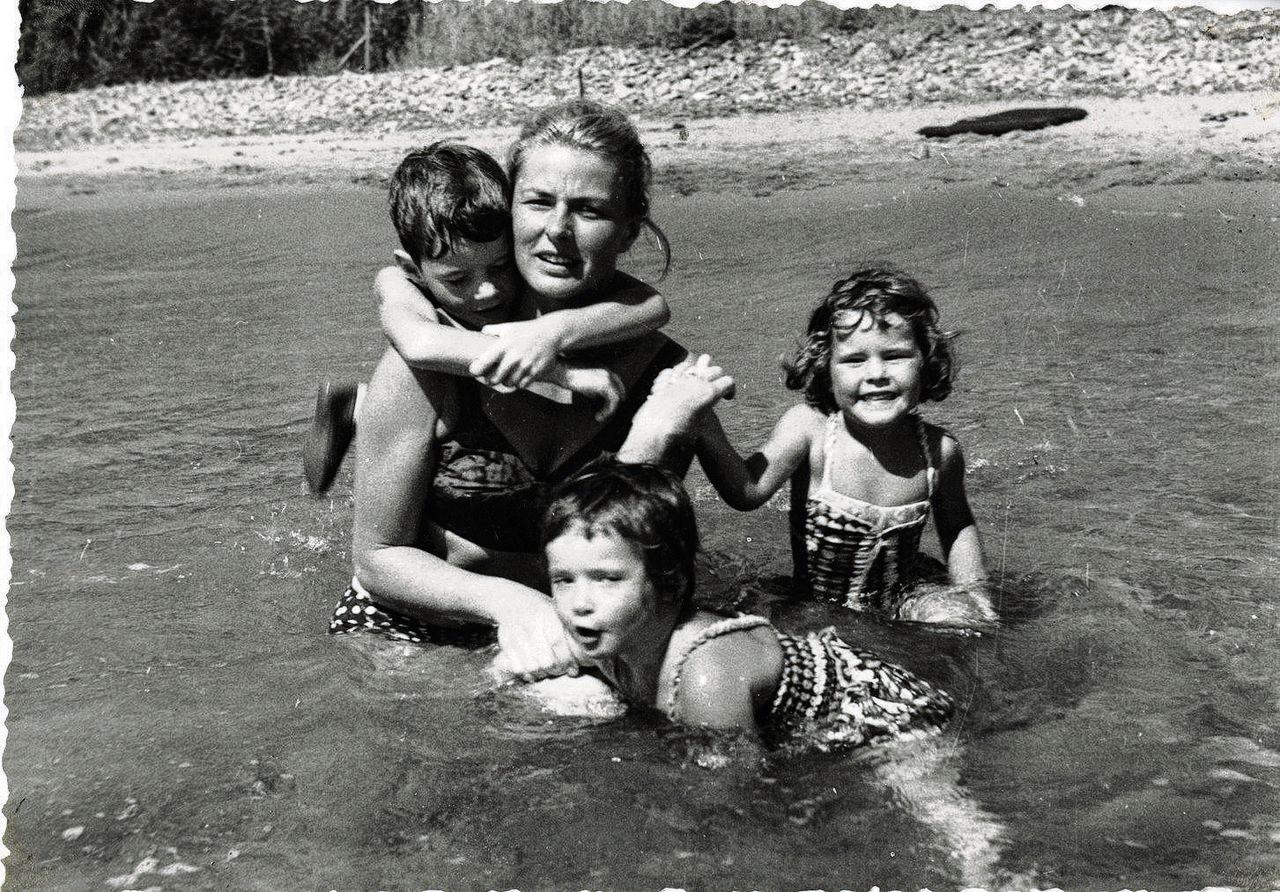
Jag är Ingrid - The movie about us is a beautiful documentary on Ingrid Bergman, her life and her "enlarged" family ...
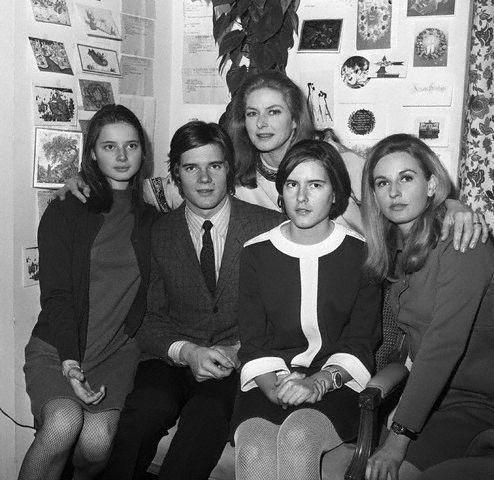
Ingrid Bergman, Isabella Rossellini, Robertino Rossellini, Ingrid Rossellini, Pia Lindstrom.
A lot of lived life, a lot of feelings, very touching, with a wonderful song in the end to give a very deep sense of melancholy about the life that goes on and slips away, while you fully live it and celebrate it.
Rossellini went out for cigarettes and flew to Ingrid Bergman. July 29,2018. In 1949 the director left Anna Magnani for the Swedish star. By Candida Morvillo.
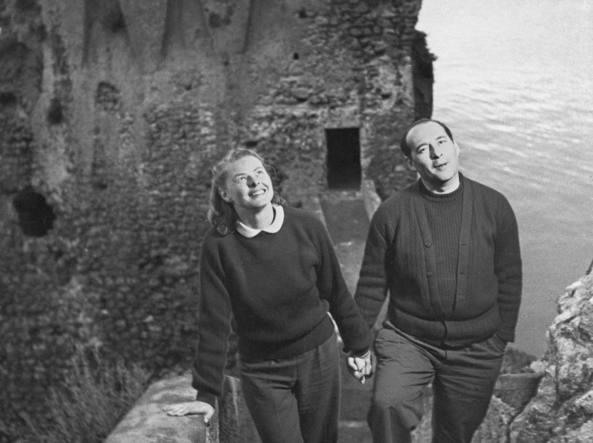
Ingrid Bergman and Roberto Rossellini in Amalfi in 1949.
In the summer of 1949, few people know where the Aeolian Islands are, but the scandal that explodes there reaches everywhere, even in Washington, on the Capitol, with Senator Edwin C. Johnson thundering against the Swedish Ingrid Bergman «a cultist of free love, distiller of evil and depravity” and against the Italian Roberto Rossellini, corrupter of morals, whose films, as Johnson asks, must not be distributed to the healthy American people.
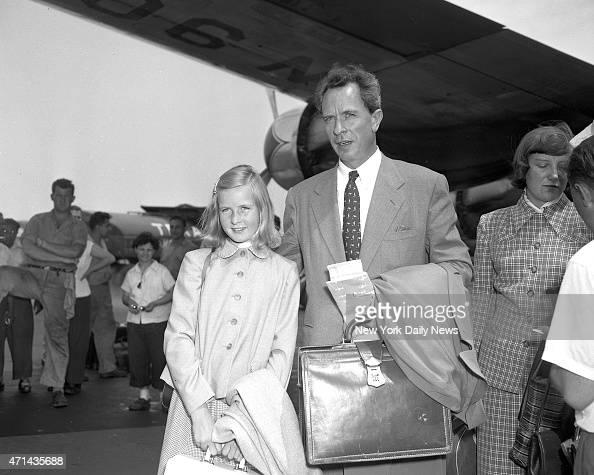

Pia Lindstrom and her father Dr. Peter Lindstrom.
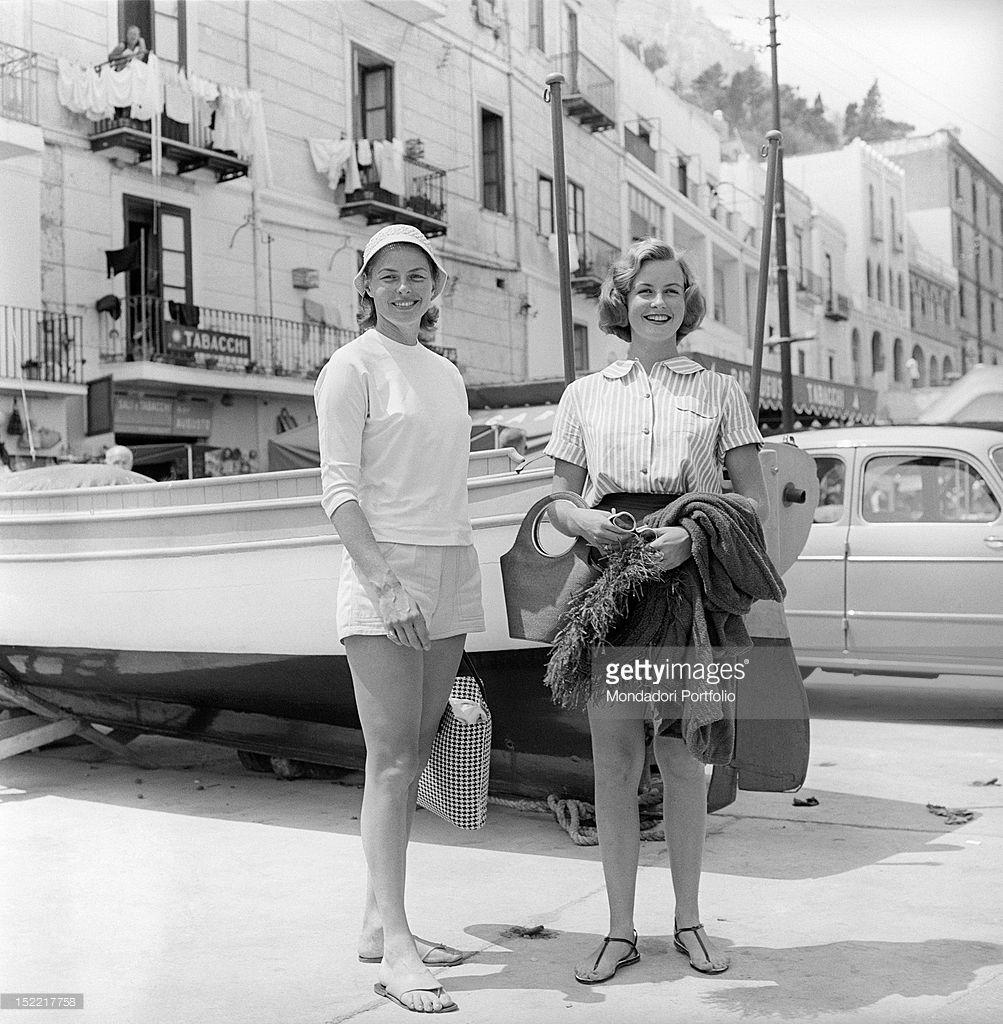
The actress Ingrid Bergman and her daughter Pia Lindstrom in a pose smiling near the pier. Capri, 1957.
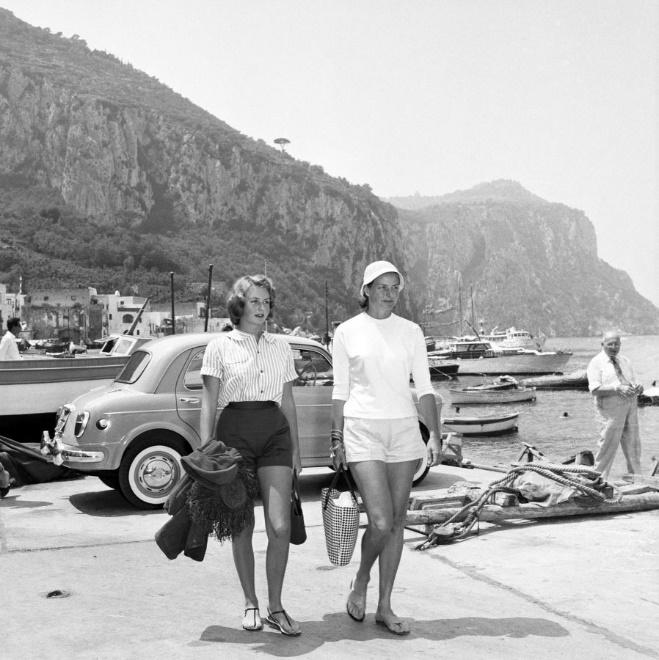
Swedish born screen star Ingrid Bergman and her daughter Pia Lindstrom, both wearing shorts in typical Capri-like fashion, walk together along the waterfront during their vacation on the Honeymoon Isle in 1957. Pia is presently visiting her mother from America and seeing other three Bergman children (by the actress's marriage to Italian film director Roberto Rossellini) for the first time. (Ingrid had a very tumultuous personal life).
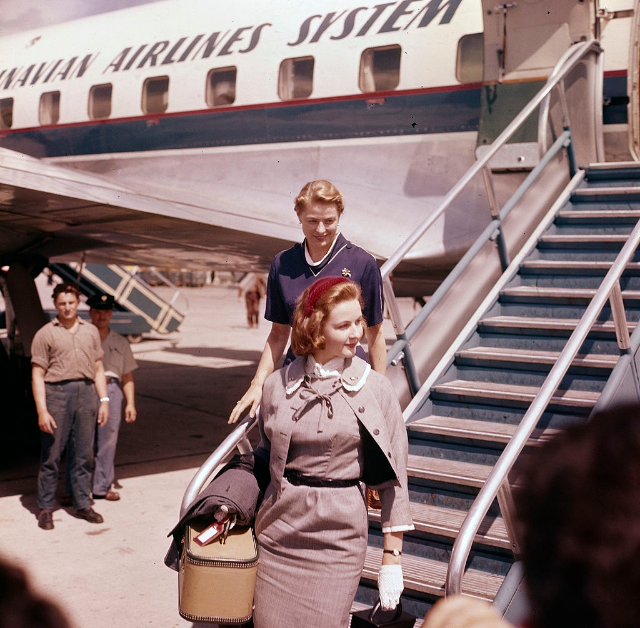
Ingrid Bergman and her daughter Pia Lindstrom getting off a plane in 1957. Photo by Francois Pages, Paris Match.
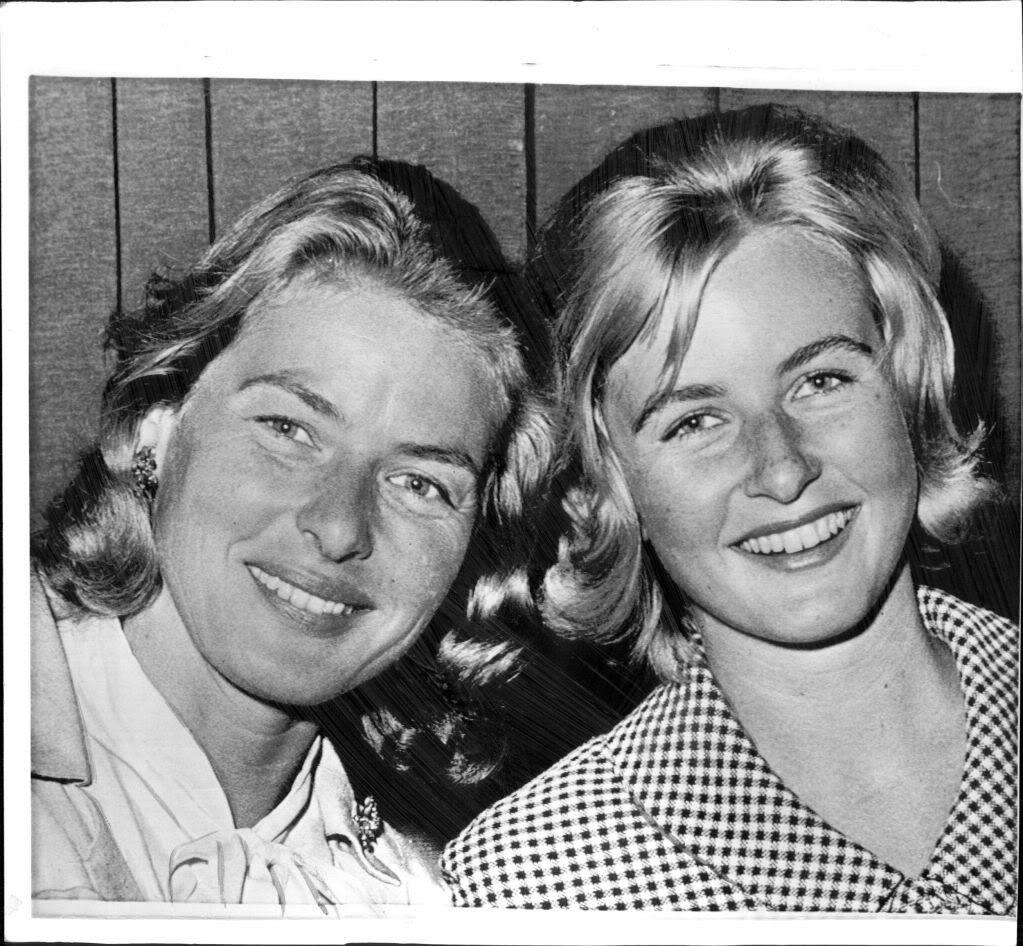
Ingrid and Pia, mother and daughter.
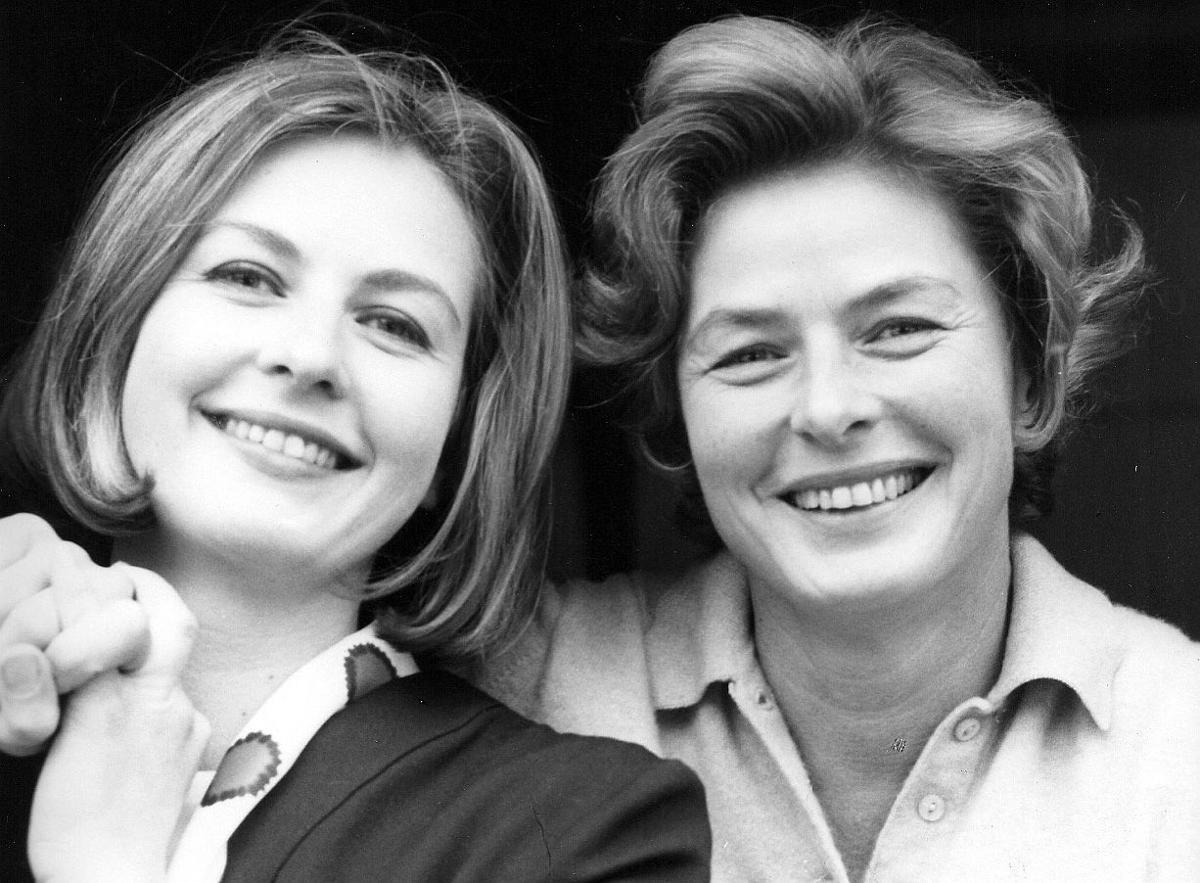
Pia Lindstrom with her mother Ingrid Bergman.
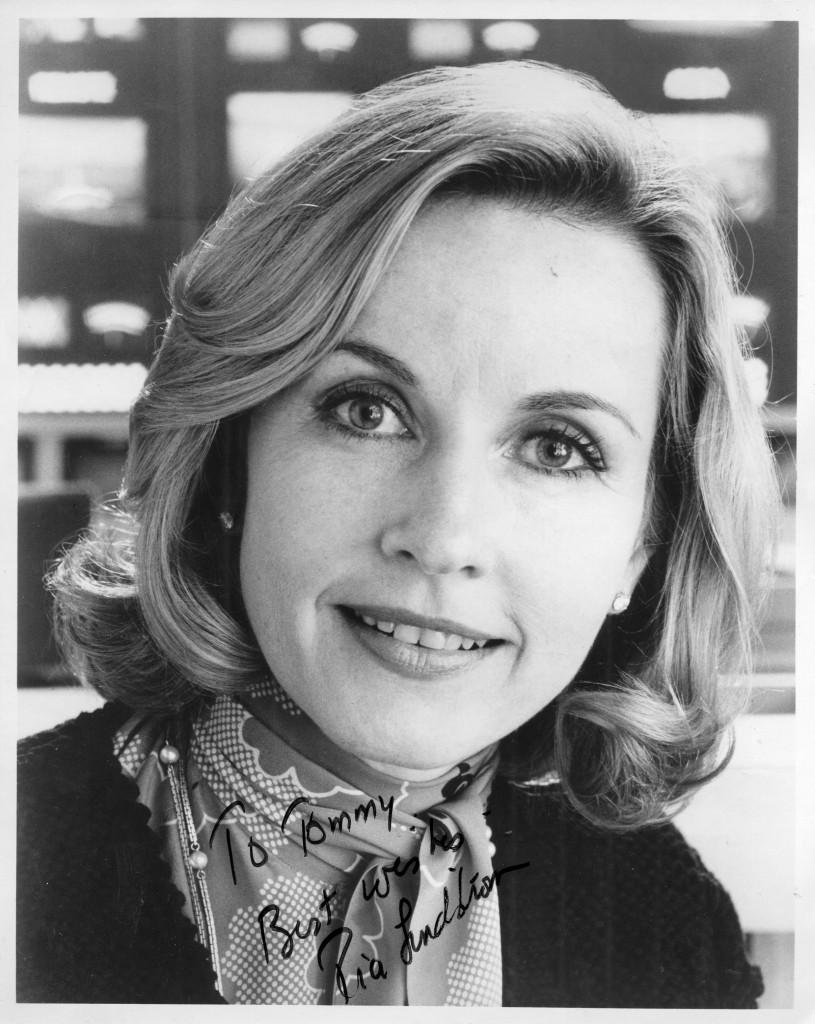
Pia Lindstrom.
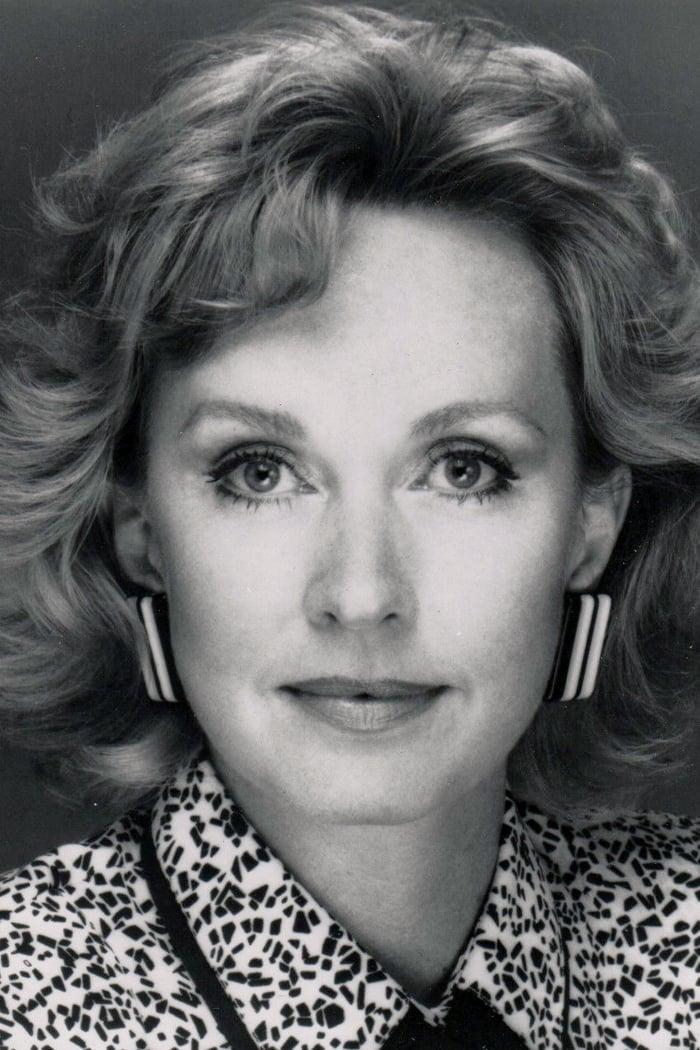
Pia Lindstrom.
The director and the actress were both married, each of them already with a child.
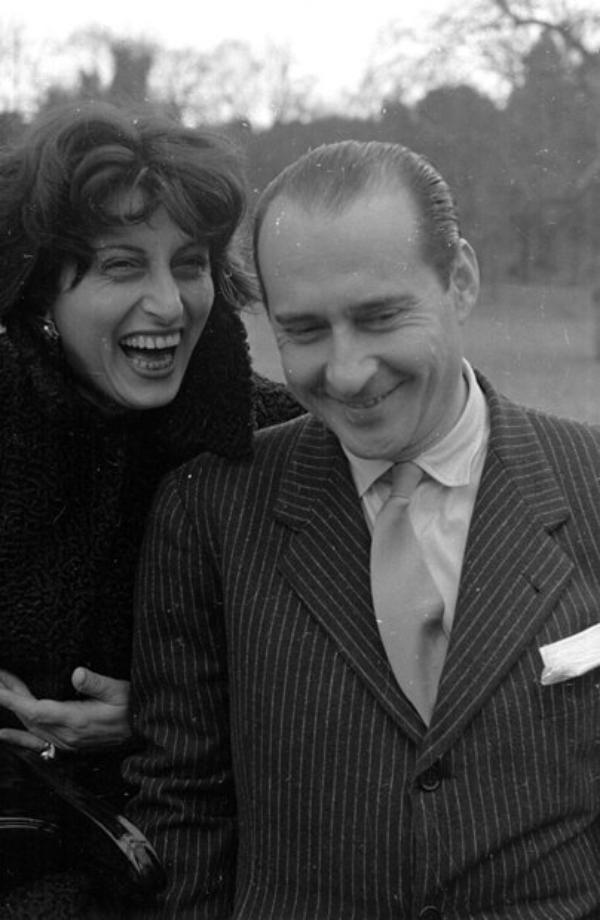
Roberto Rossellini with Anna Magnani.
Roberto, moreover, lives in sin with Anna Magnani. They have just fallen in love and the whole world is talking about it.
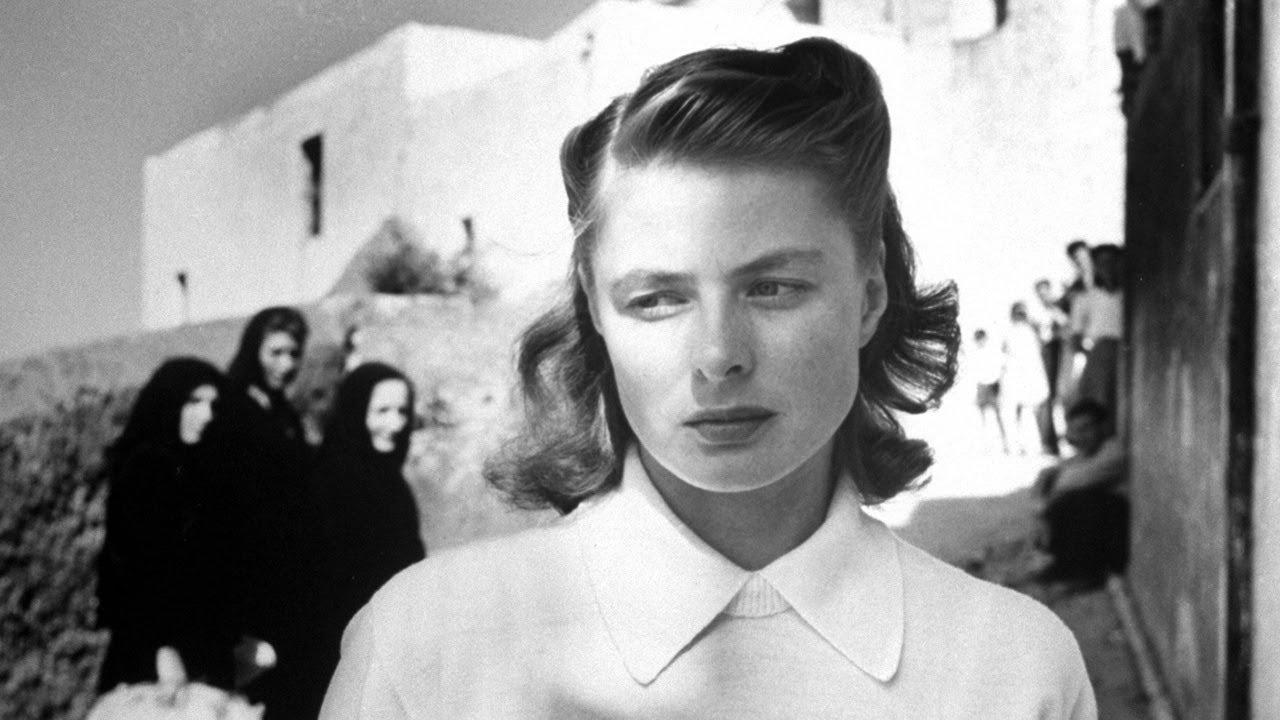
It is impossible not to know that, in Stromboli, a film directed by Rossellini and starring Bergman is being shot and, in nearby Vulcano, an almost identical one is being shot starring Magnani, who was supposed to interpret the other, but when she was left, she had set up a sister production to show "that intriguer Bergman" that she was the only star of neorealism.
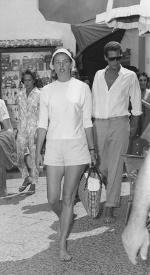
Ingrid Bergman. Image courtesy mptvimages.com.
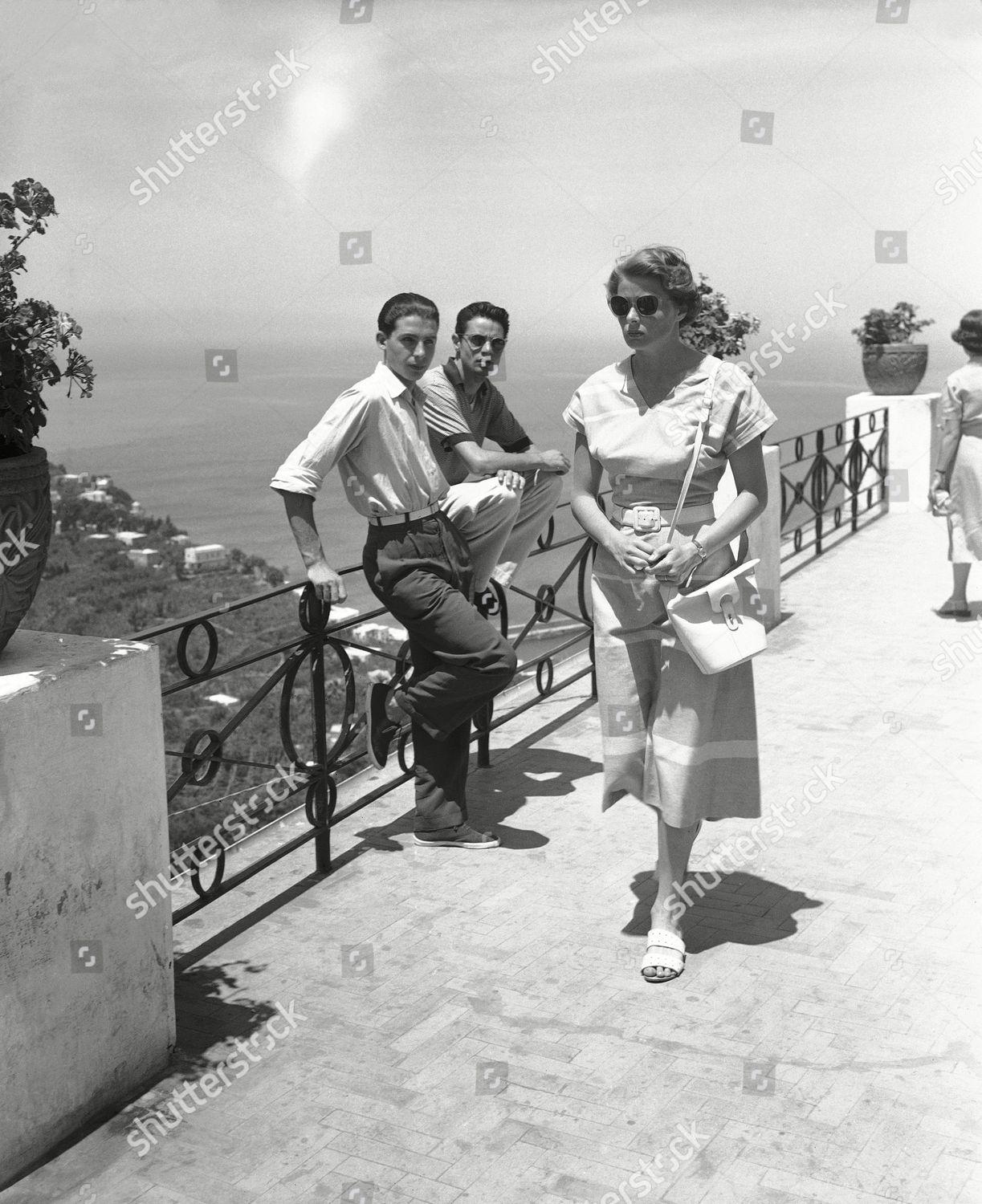
Ingrid Bergman in Capri, Italy. Shutterstock editorial.
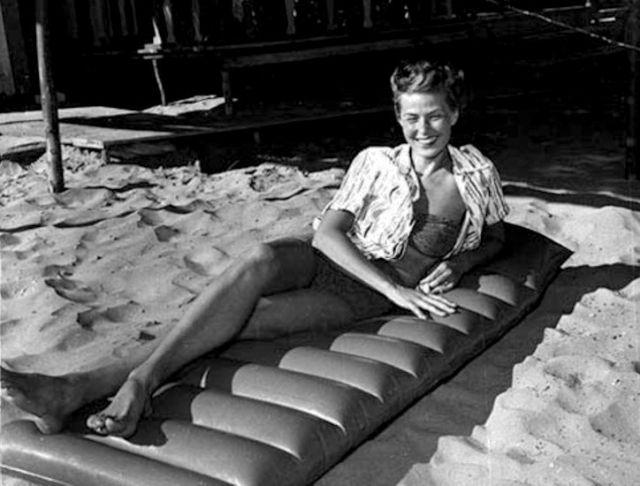
In times when similar events remain confined to magazines, the triangle is instead on the New York Times, Washington Post, Figaro and so on.
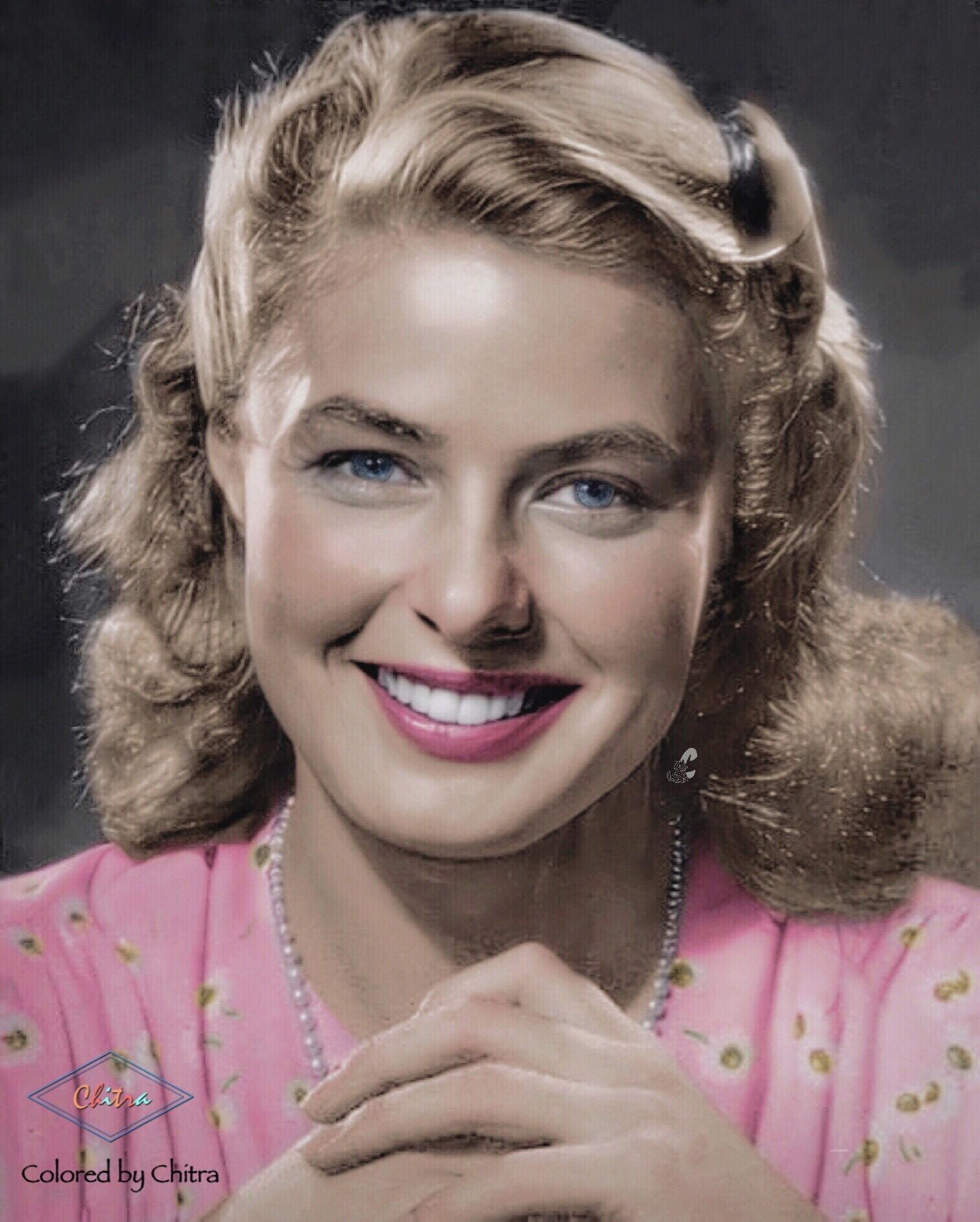
In the Corriere, Irene Brin will write about Bergman's embarrassment in shopping in the markets of Rome, at that point we are already at the marriage between the director of "Roma città aperta" and "Paisà" and the diva of "Casablanca" and "Per chi suona la campana», voluntarily confined to washing dishes, with detergents that she gets sent from New York and lines up on a shelf as if they were Oscars.
It all begins on May 7, 1948, that day Roberto turns 42. He has long been separated from his wife Marcella de Marchis, costume and set designer and lives with Anna at the Grand Hotel Excelsior. They met in '44, to film "Rome, open city".
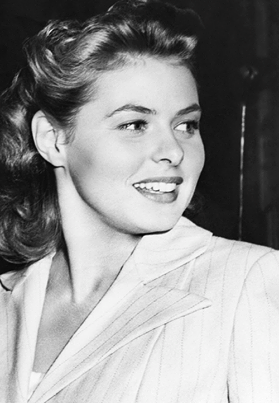
That May evening, the director receives a letter from Ingrid Bergman. He tries to arrange a meeting without Anna's knowledge, but she has a thousand eyes and ears. When the Swedish telegram arrives to fix the appointment, Rossellini and Magnani are at the table. He doesn't open it, she continues to serve him spaghetti. "Okay like this? Do you want more sauce? Do you want chili?» As soon as the dish is ready, she spills it on his head. The outbursts of «Nannarella» are legendary.
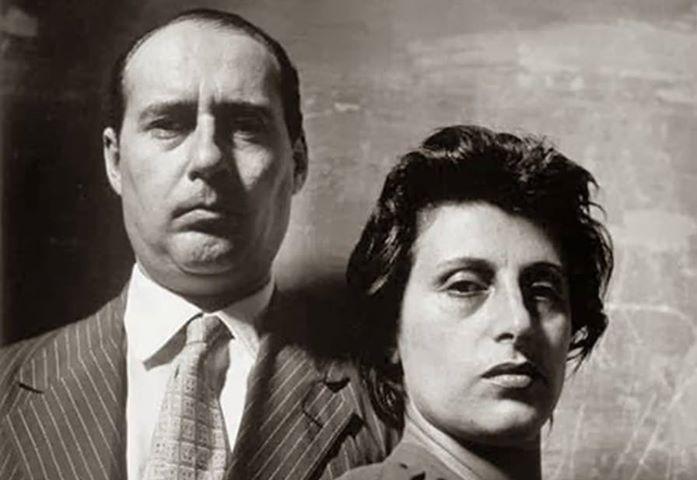
Roberto Rossellini and Anna Magnani.
The evening that Rossellini leaves for America to meet Ingrid, he exits the Excelsior telling Anna that he is going to buy cigarettes and he is no longer seen, until the photos of him and Ingrid getting off the plane in Rome. Only then he calls her to tell that Ingrid will act in "Stromboli". It's the end of March.

On April 3, Roberto and Ingrid are in Amalfi, she writes to her husband Petter Lindstrom and asks for a divorce.
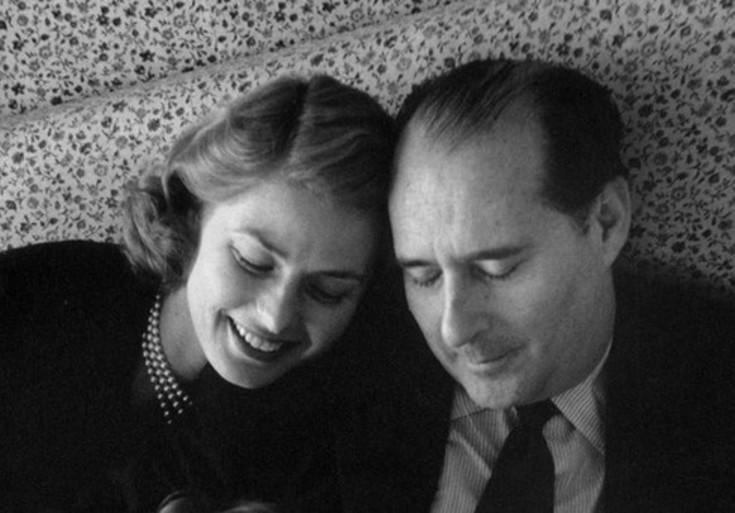
Ingrid Bergman and Roberto Rossellini.
The two lovers are so in love that they leave a photo hand in hand to the owner of the Luna Convento Hotel. A few weeks later, when already shooting in Stromboli, Life publishes it and all hell breaks loose.
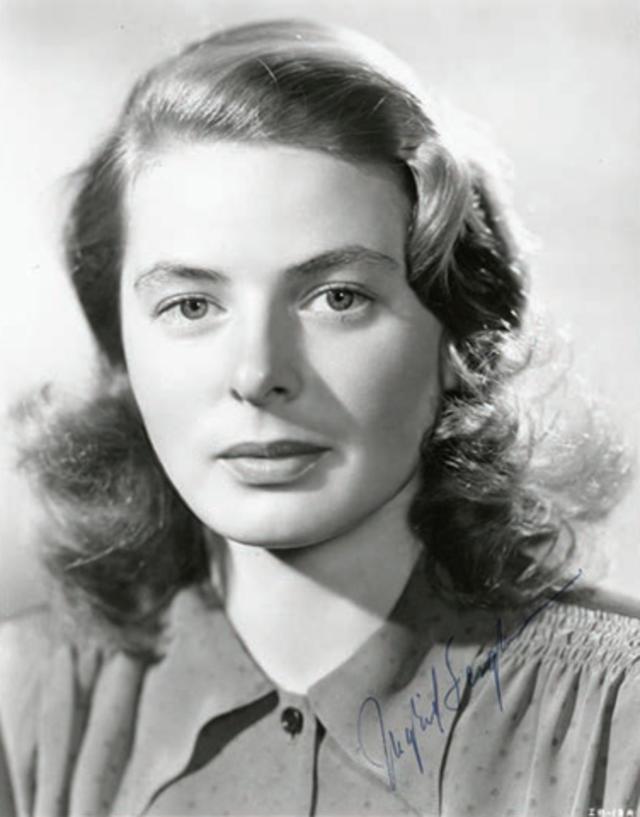
Journalists and onlookers disembark with the steamers, Ingrid is releasing the film in which she plays Joan of Arc and the producer Howard Hughes is desperate: she, cold, composed, mother of a family, has so far embodied the icon of a puritanical and traditionalist America and Hughes fears that audiences will punish her by deserting the film.
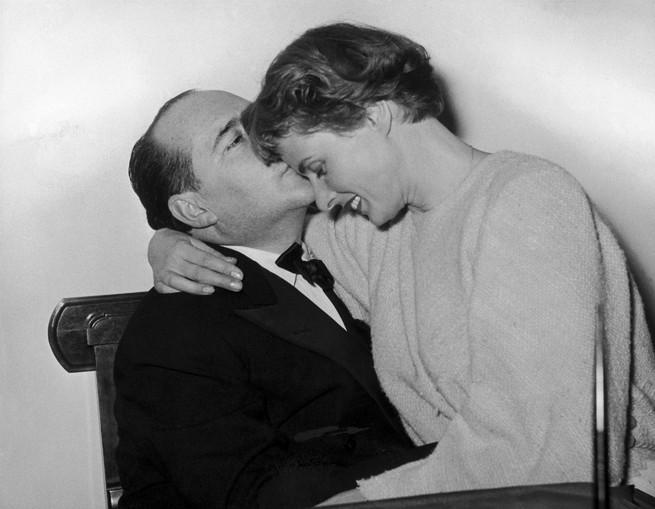
Roberto and Ingrid.
Every morning, in the little red house where the two lovers stay in separate wings, the postman leaves insulting letters to Ingrid, guilty of betraying her husband and abandoning a six-year-old daughter. They come either from ordinary people or from acquaintances and friends and the latter are the fruit of the campaign of "moral suasion" hatched by Hughes, who asked anyone to write to dissuade her.
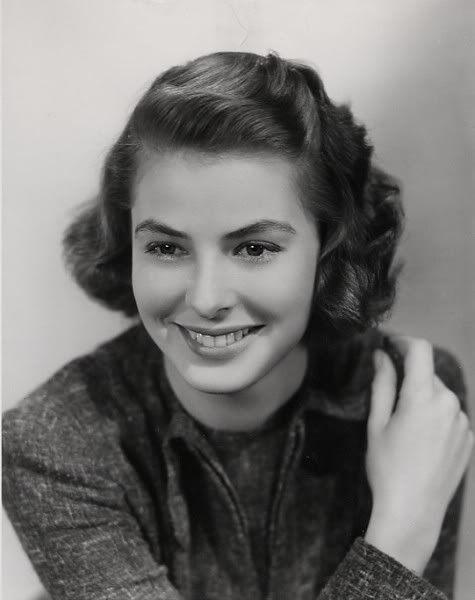
Only Ernest Hemingway, as Marcello Sorgi tells in “Le amanti del vulcano”, takes pity on her and writes to her: «listen to me, my child, I want to make you a little talk. We have only one life in front of us (…). You are a great actress. Great actresses always have big trouble, sooner or later; if they don't have them, it means they're bitches (you can delete the bad words). And everything that great actresses do is forgiven».
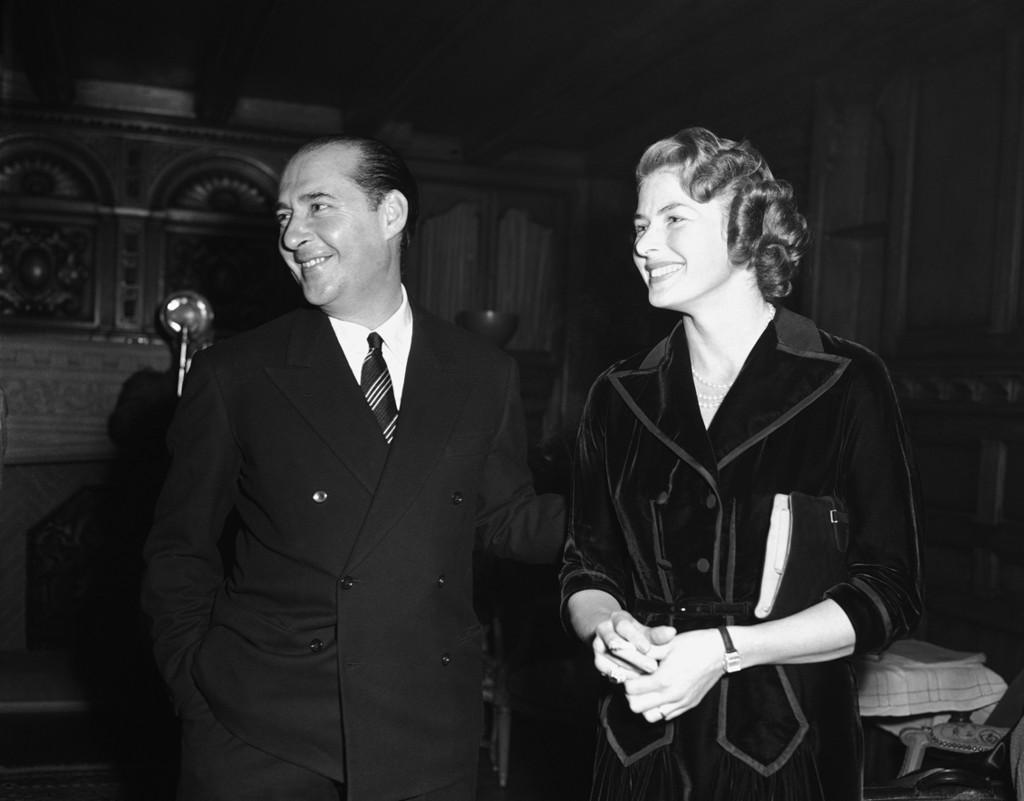
Roberto Rossellini and Ingrid Bergman.
While in Stromboli they try to contain the scandal, with patrols to keep intruders and journalists away, on 7 June, Anna Magnani lands in Vulcano and here everyone, instead, to advertise themselves, has an interest in blowing on the fire of the rivalry between the two films and the two actresses. Her challenge is to finish before the cheater, who has a two-month advantage but is lazy, rewrites the script, wastes time, drives the producers crazy. At night, Anna looks at the distant glows on the sciara del fuoco of the Stromboli and threatens Bergman to come out stunned by the confrontation.
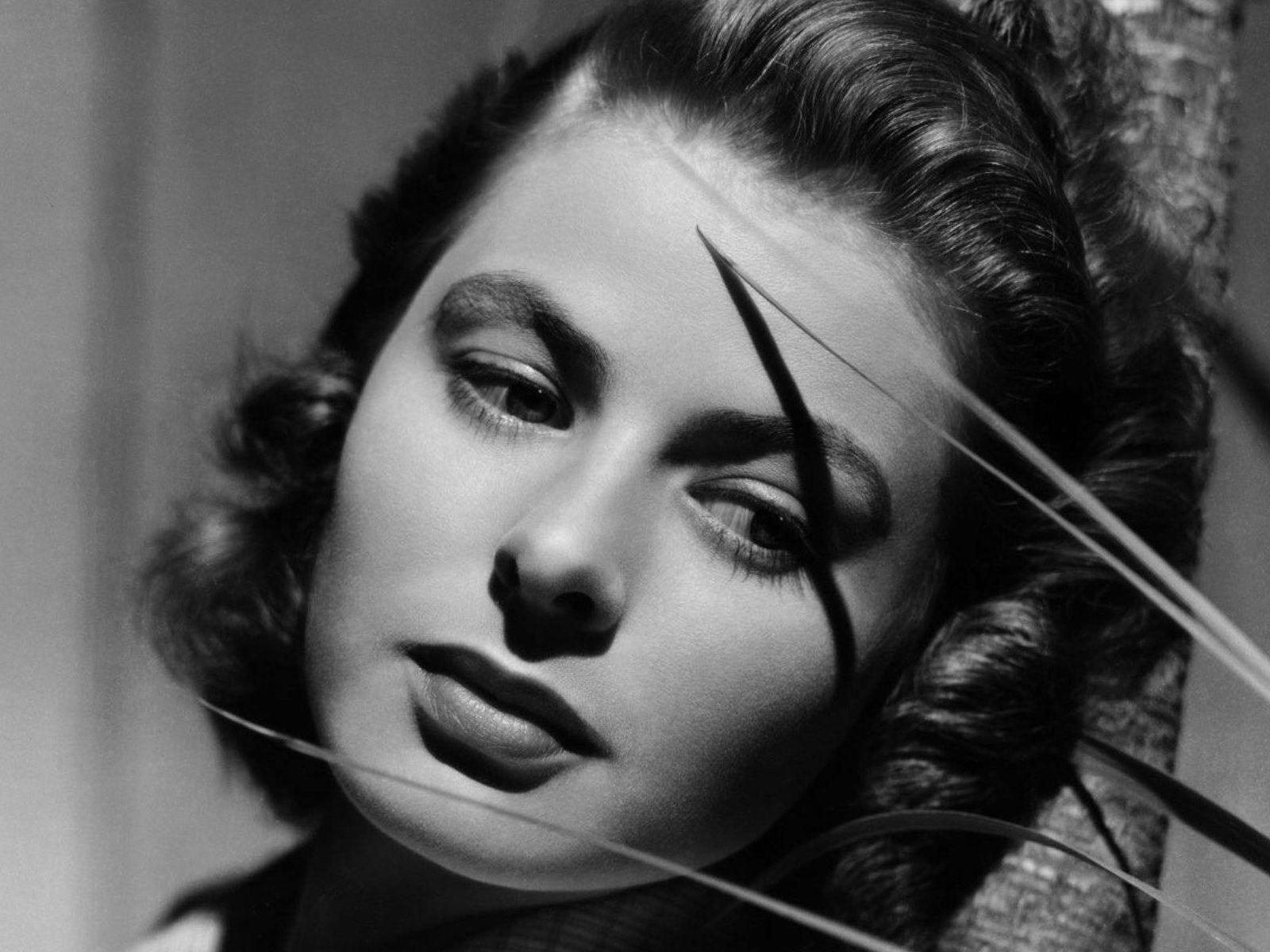
Meanwhile, on the set, the Swede realizes that she is pregnant.
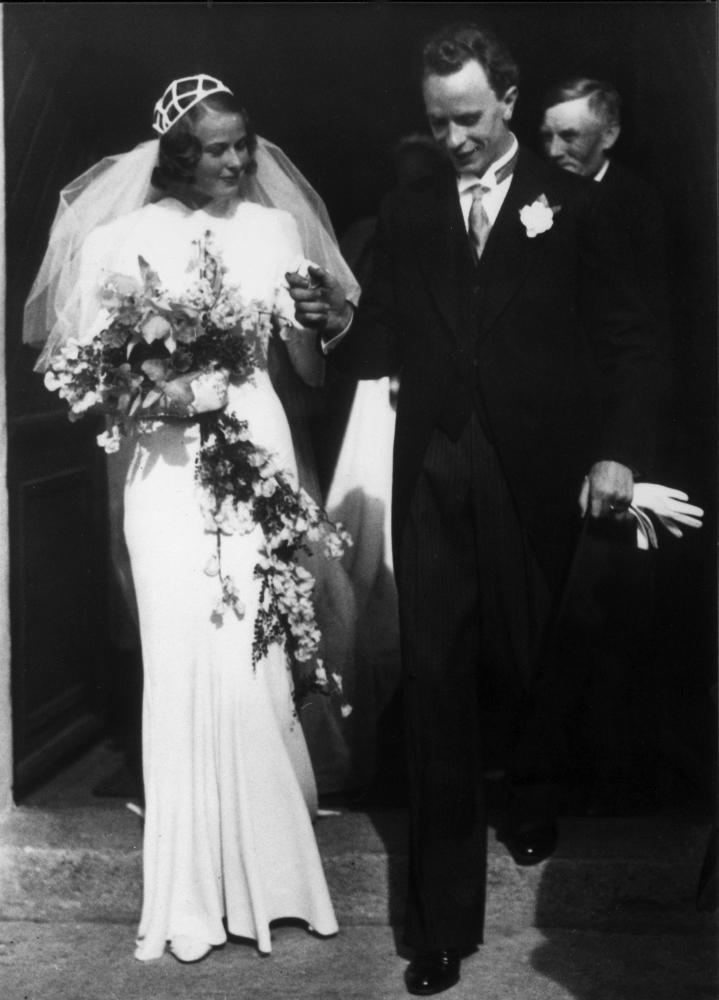
Ingrid Bergman wed her first husband Petter Lindström in a caged Juliet cap and pin curls, 1937.
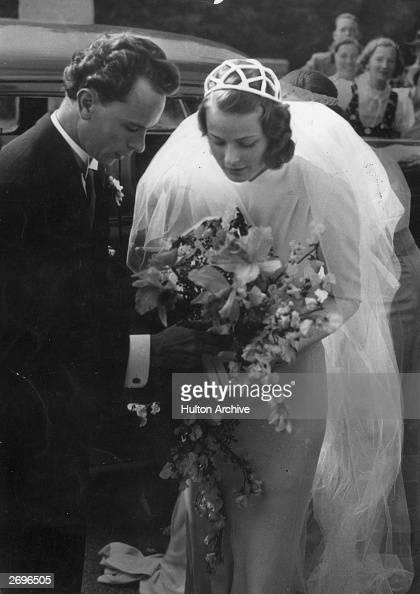
Ingrid Bergman wed Petter Lindström, a dentist who later became a neurosurgeon, in 1937.
On August 4, returned to Rome, she issues a statement to say that she divorces her husband Petter Lindstrom and leaves the cinema. Rossellini will get a divorce from his first wife with a ploy, with Marcella taking citizenship in Austria, where, unlike Italy, divorce is allowed. The Vatican goes so far as to threaten a violation of the concordat.
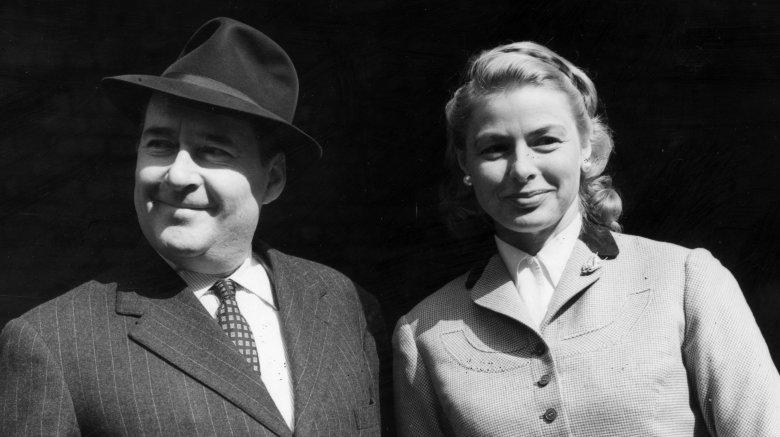
Roberto Rossellini and Ingrid Bergman.
The first film to come out was «Vulcano», in February 1950. Anna beat Rossellini to the punch, also because he is arguing with American producers, who would like to cut the scene in which Ingrid gets converted and which they consider blasphemous. But, at the premiere of «Vulcano», the projection jams. Once, twice ... four times. In the room, there is talk of sabotage.

Ingrid Bergman and Roberto Rossellini.
Then the reporters leave: the news arrives that Ingrid has given birth. It will end after Rossellini and Bergman have had three children and made five films, all of which fail. He doesn't want her to work with others, then she makes a film in Paris with Jean Renoir, he goes to film a movie in India, comes back with the screenwriter Sonali Das Gupta, got pregnant by him. A new divorce. The end of the story. Anna had already taken her revenge, in 1953, bringing "Bellissima" to America and, in 1956, by winning the Oscar with "La rosa tatuata”. And, without Rossellini, Ingrid starts winning Oscars again. A cancer patient, she will call Roberto next to her in Paris to greet him one last time. Anna will want him at her bedside too. And, when he has a heart attack, the person he calls and in whose arms he will die is Marcella, his first wife.
The wedding gift Ferrari from Roberto Rossellini to Ingrid Bergman. Price realised USD 288,500. Closed: 16 August 1998.
“The minute I looked at her, I knew I had something. She had an extraordinary quality of purity and nobility and a definite star personality that is very rare. But she acted like a movie-struck teen-ager. I remember having a party for her at my home. Spencer Tracy, Charles Boyer and a dozen other movie stars were there. She just sat in a corner staring at them in awe. She was so shy she couldn't stop blushing”. David O. Selznick
And so a star was born. It was May, 1939, when Ingrid Bergman first arrived in Hollywood and her first movie was "Intermezzo", a love story. The director was Gregory Ratoff. In later years, Ms. Bergman recalled that he was forever correcting her English, though his own accent was usually incomprehensible. On the other hand, her Swedish background gave her a natural flair for languages and she conquered English speedily. The first movie proved to be an enormous success and she was hailed by most American film critics as possessing poise, intelligence, naturalness and a unique aura.
She returned to Sweden in the late summer and vowed that she would return to the United States to star in Joan of Arc in 1940. However, her plans were changed when World War II broke out in Europe and delayed her ability to return. In the meantime, David Selznick had picked up Ms. Bergman's option and immediately upon her return loaned her out to Columbia Pictures for whom she made a number of highly successful movies. In 1944, she played opposite Charles Boyer in Gas light, for which she was awarded an Oscar for best actress at the Academy Awards securing her role as one of Hollywood's premiere actresses.
During this time, she had formed a good friendship with a brilliant photographer, Robert Capa, who talked much of the cinematic exploits of Italian film director, Roberto Rossellini, who was then age 43 and known as the 'father of the post-war Italian neo-realistic school of film'. Rossellini had created a sensation world-wide with Open city and Paisan. Ms. Bergman saw both films repeatedly and, in early 1948, found herself so galvanized that she sat down and wrote Rossellini the ‘famous letter’ we talked about earlier.
Rossellini cabled back: I HAVE JUST RECEIVED WITH GREAT EMOTION YOUR LETTER WHICH HAPPENS TO ARRIVE ON THE ANNIVERSARY OF MY BIRTHDAY. IT IS ABSOLUTELY TRUE THAT I DREAMED OF MAKING A FILM WITH YOU AND FROM THIS VERY MOMENT I WILL DO EVERYTHING TILL SUCH A DREAM BECOMES REALITY. I WILL WRITE YOU A LONG LETTER TO SUBMIT TO YOU MY IDEAS. WITH MY ADMIRATION PLEASE ACCEPT THE EXPRESSION OF MY GRATITUDE TOGETHER WITH MY BEST REGARDS. ROBERTO
And so began a beautiful relationship. Ms. Bergman left Hollywood for England to make Under Capricorn, produced by Alfred Hitchcock and, during the filming, she met Rossellini in Paris where they worked out the details for Stromboli to be filmed in Italy. Rossellini returned to Rome in February of 1949 and Ms. Bergman followed him in March. Soon rumours of a love affair between the actress and the Italian director were spreading in the European and American press. Friends and relatives of both parties were soon expressing disapproval of the affair. In February of 1950, Stromboli was released and simultaneously Ms. Bergman gave birth to a baby boy, Robertino, in a clinic in Rome. The news of her pregnancy had been broken by Louella Parsons in December 1949 and the scandal that erupted assumed major proportions. A week after her son was born, Ms. Bergman filed suit for divorce from her first husband and, in May, she underwent a proxy marriage to Rossellini.
During 1950 and 1951, the Rossellini/Bergman thing continued to be the 'piece-de-resistance' of the international gossip sheets. When Ms. Bergman's twin daughters Isabella and Isotta were born in June 1952, the dust had settled and Ms. Bergman's reputation had been regained. Meanwhile, she was completing Europa 51, We the women and Viaggio, three Rossellini hits.
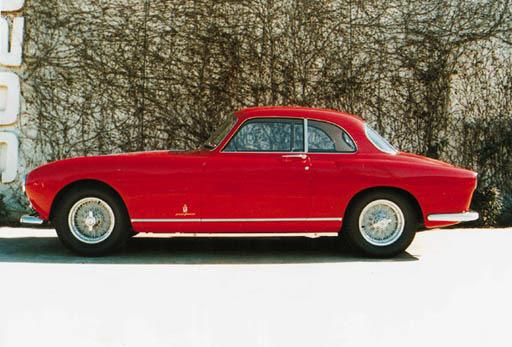
1953 Ferrari 212 Inter coupe’. Coachwork by Pinin Farina. Chassis n. 0265 EU. Engine n. 0265 EU. Ferrari red with biscuit leather interior with black piping. Engine: Ferrari V12, 2,562 cc, 68x58.5 mm, 180bhp at 5,500 rpm, triple 36 DCE3 Weber carburettors. Gearbox: 4-speed manual. Suspension: front - independent double wishbones, transverse leaf springs, rear - rigid axle, semi-elliptic leaf springs. Brakes: four wheel drum. Left hand drive.
In April of 1951, Ingrid and Roberto Rossellini were visitors at the Turin Auto Show, where they viewed the new Ferrari 212's. Ingrid was impressed by the sleek design and outstanding coachwork. She convinced Roberto that he should purchase for himself a Ferrari Vignale Spyder. In return, Rossellini vowed to give Ingrid a Pinin Farina Coupe as a wedding present. They selected Pinin Farina as the coachbuilder because of Ingrid's friendship with the Pinin Farina family. The Ferrari was completed in early 1953 and was assigned the chassis number of 0265EU. Ingrid was elated with her new 212 and referred to it as her 'growling baby'.
The Ferrari 212 series was among the first collaborations between Ferrari and Batista Farina's world famous Carrozzeria Pinin Farina (later Pininfarina). It formed the basis of a successful relationship lasting more than forty years with Pininfarina as the sole arbitrator of design for Ferrari.
The rolling chassis for the 212s were delivered by Ferrari to the old Pinin Farina works at Corso Trapani, Italy, where the bodies were expertly handcrafted. The entire plant production of Pinin Farina for 1953 was only 902 cars, a clear statement of Battista Farina's mandate of and commitment to, quality.
0265EU was delivered on December 12, 1952 to Pinin Farina from Ferrari for mounting of the coachwork and fitting of the interior. The 'growling baby' was delivered to Mr. Rossellini in Rome prior to its presentation to Ingrid. Ingrid and Roberto were passionate about their Ferraris and Roberto enthusiastically supported the marque by entering into competitive events, including the 1953 Mille Miglia.
The 212 eventually migrated to California and, after a number of successive owners, was completely dismantled for restoration. After nearly four years worth of painstaking restoration, the 212 was shown at numerous concours and has won many laurels including: 1985 Pebble Beach Best in Class; 1985 Watkins Glen Best in Class; and has been documented extensively in Cavallino magazine n. 35. In 1996, Mr. Lee, the present owner, returned the 212 to have the restoration 'freshened up' by Smith Coachworks. This immaculate 212 has a wonderfully romantic history and would be a star attraction of any concours, or an historically important entry for events such as the Mille Miglia, Tour de France and Colorado Grand.
Rossellini, Bergman and the Ferrari 212. By Giosue’ Boetto Cohen. February 19, 2016.
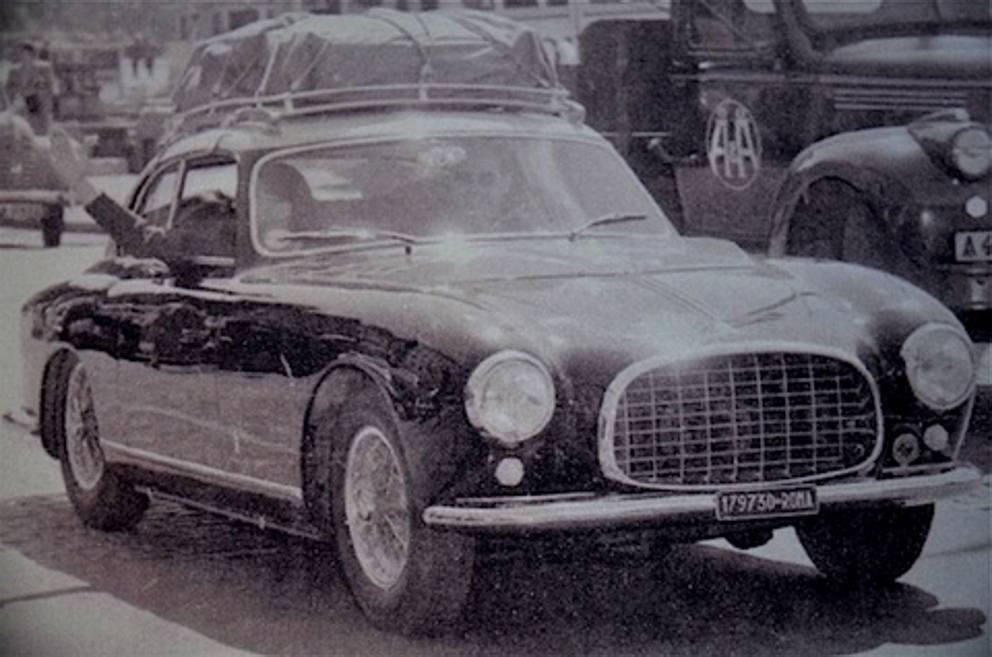
The Ferrari 212 Inter of Roberto Rossellini and Ingrid Bergman travelling to Stockholm, on the Swedish website Svammelsurium.
Must be a band of pranksters those of the Swedish blog Svammelsurium (translatable into: "those of the hot waffles?" Who knows!) who, on the title page, praise non-ecological cars (in Sweden ?!) and warn against bands that enliven the summer on the Baltic. Maybe it's all a play on words, but they got a scoop. A real gem.
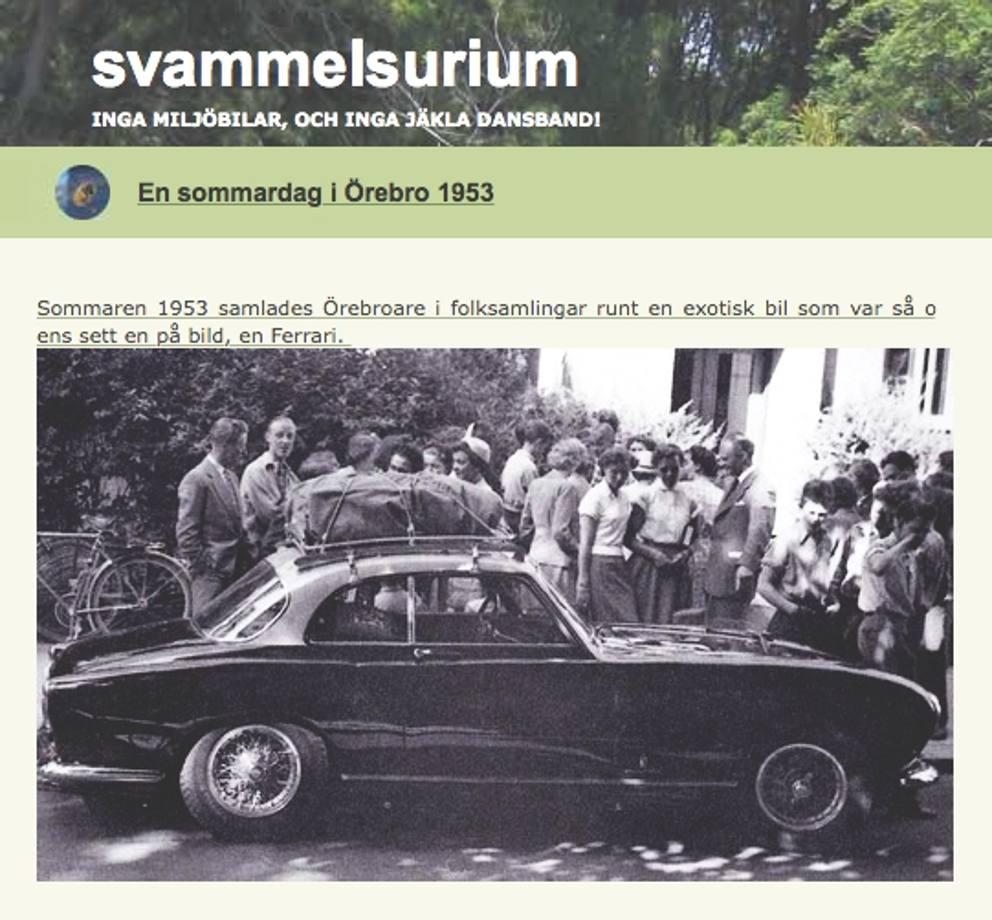
Some of the bloggers found, who knows where, this photo from June 1953 (you can also see it above). Inside is a beautiful car, a Ferrari 212 Inter, with Pininfarina bodywork. It is surrounded by a small crowd, in the remote town of Orebro, which will also be the sixth largest city in Sweden, well placed on the Gothenburg-Stockholm highway, but for us it remains an unlikely place. People have a nice look at it, because they've never seen one. In the leading country of social democracy - the one whose austere citizens thought that in Italy we were all millionaires, judging by the furs and custom-built cars - in '53, they had only registered one Ferrari.
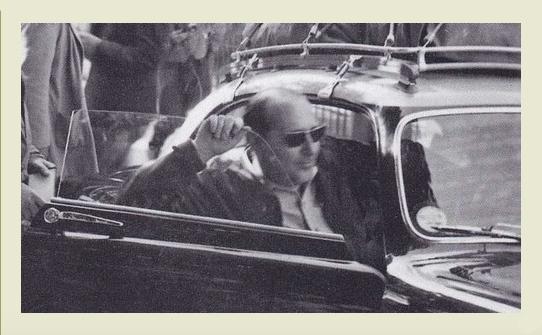
Rossellini in Orebro gets on the Ferrari 212.
Another very strange thing, returning to the photo, is that a roof rack is screwed onto the precious and two-tone roof, loaded like that of a Fiat 600. Who will these exotic travellers ever be (the license plate is not seen, but it is from Rome) who pulled the handbrake and fled to the pastry shop (excellent, at number 12 on Olaigatan, according to the post by Caroline, who was then eight years old)? The circle is closed: none other than Roberto Rossellini and Ingrid Bergman are in the car, on their way to the capital to receive a film award. The 212 is a gift from the director to his wife, the idea of the trip is an opportunity to take a tour of her beloved native country. Which is still today a paradise for those who love to drive. Let alone back then.
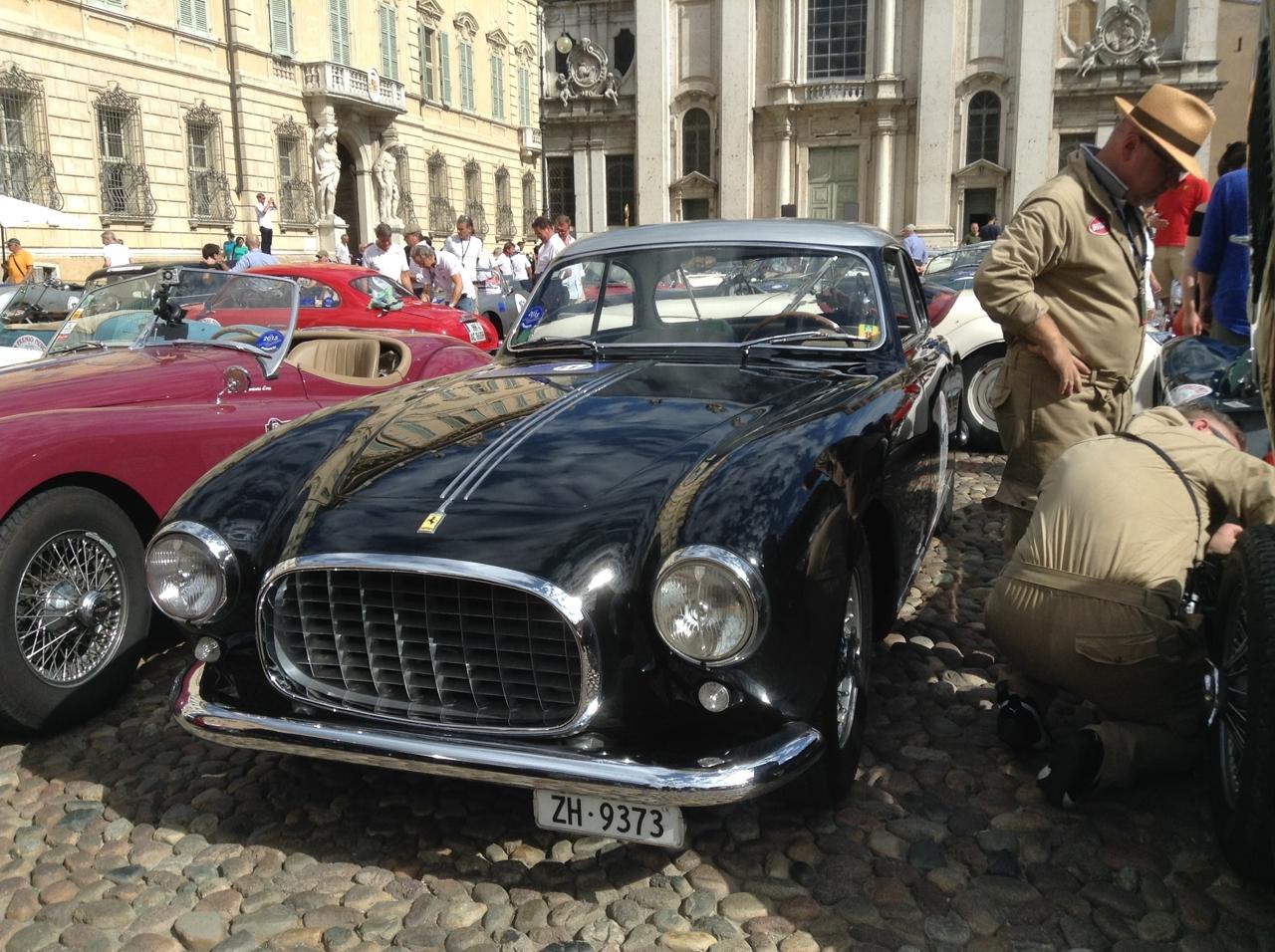
Nuvolari Award 2015, the Ferrari that belonged to Rossellini is now owned by a dentist from Zurich.
Sixty-three summers have passed, the black and silver coupé has changed hands several times, but it still exists today, even though it is "only" driven by a dentist from Zurich.
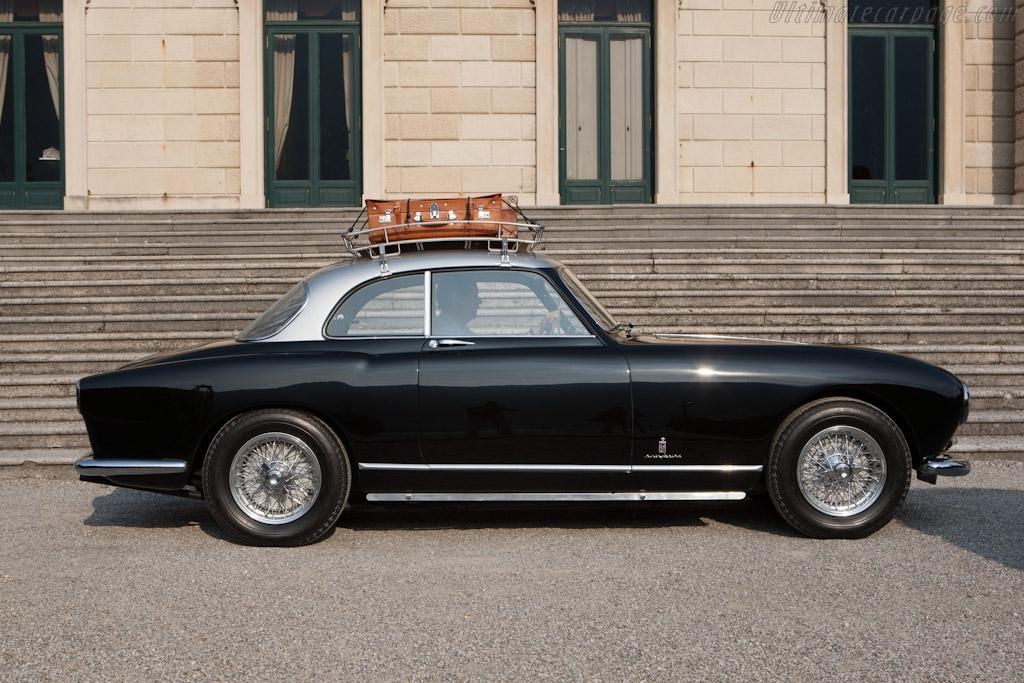
Rossellini's Ferrari at Villa D'Este in 2013.
On the other hand, it is worth a little more (last known price was $ 812,438) and always has its romantic roof rack.
Rossellini’s (and Bergman’s) Ferraris. September 29, 2016.
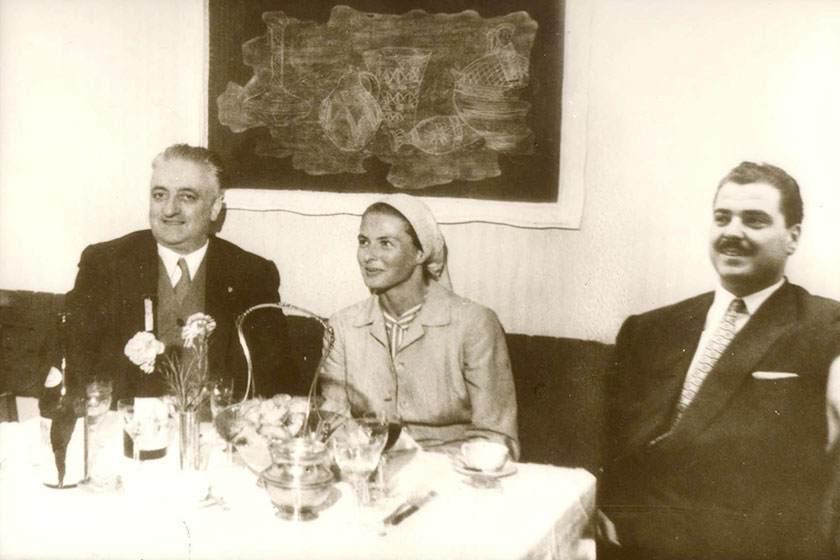
Enzo Ferrari, Ingrid Bergman and Giorgio Fini.
Bergman starred in six of Rossellini’s films and, important to our tale, she got caught up with another of Rossellini’s loves, Ferrari automobiles.
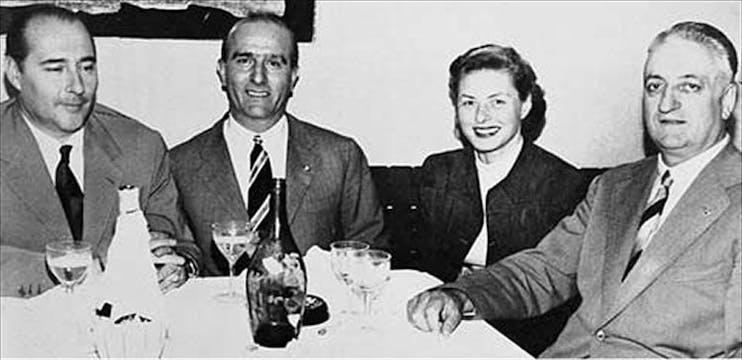
From left to right: Roberto Rossellini, Giuseppe "Nino" Farina, Ingrid Bergman and Enzo Ferrari. Credit: My Car Quest.
Rossellini was a friend of Enzo Ferrari and owned a goodly number of Maranello products, including a 1952 212 Inter Europa Coupe, a 1953 250 MM Vignale and, later in this tale, a 1954 375 MM. He entered the 250 MM in the 1953 Mille Miglia, as reported in an Associated Press item datelined Rome, April 17, 1953.
In part the item reads: “with the grudging approval of wife Ingrid Bergman, movie director Roberto Rossellini made ready to drive his car in Italy’s tough, dangerous 1,000-mile auto race…. ‘Forbidden things are always so desirable,’ said the blonde Swedish actress. ‘I thought if I said ‘yes’ he wouldn’t enter the race. Now I’m surprised.’”
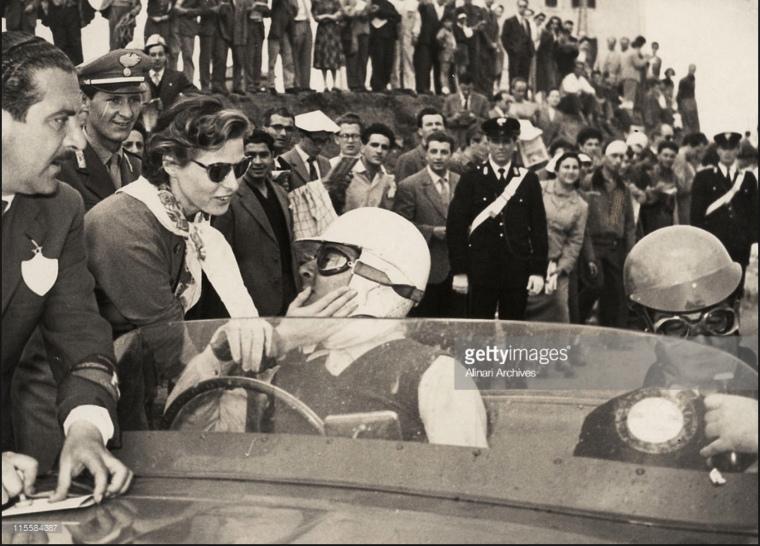
Bergman, driver Rossellini with his co-driver and cameraman colleague Aldo Tonti at the start of the 1953 Mille Miglia. Image from classicdriver.com.
Official records have Rossellini and Tonti’s n. 544 dropping out with a failed differential after 7 hours 28 minutes 26 seconds. An unofficial report has it that Bergman threw herself on the hood of the 250 MM at the halfway mark in Rome. Certainly a good story….
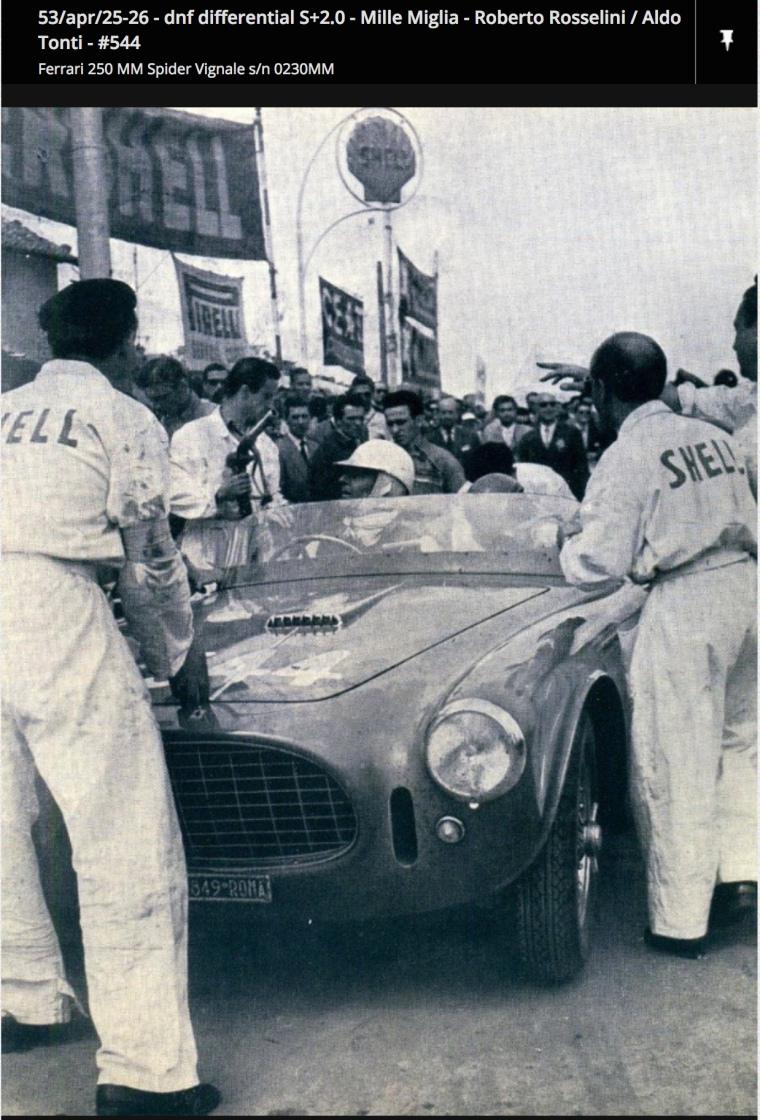
Rossellini and Tonti’s Ferrari 250 MM Vignale, 1953 Mille Miglia. Image from: http://www.barchetta.cc.
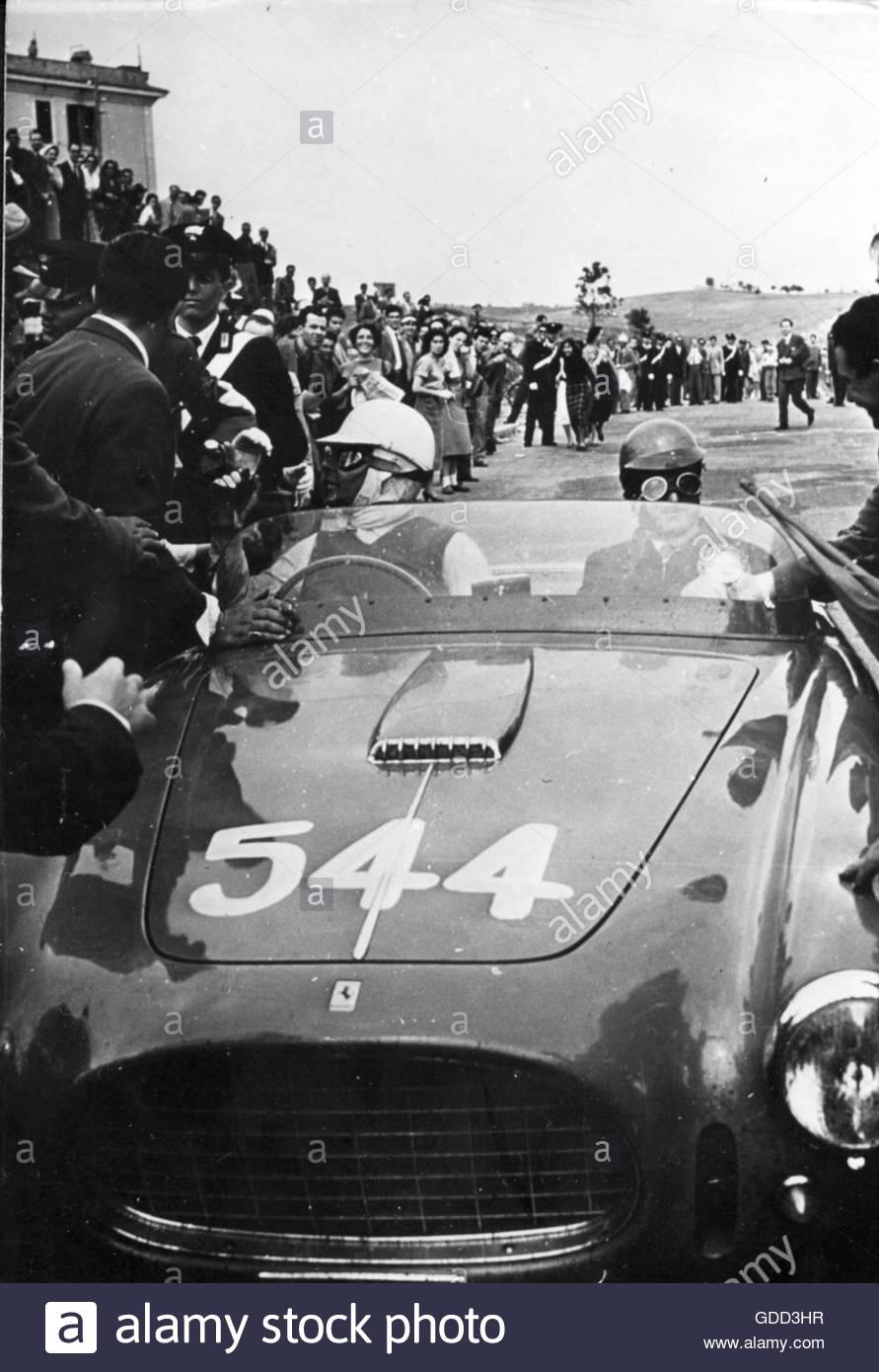
Rossellini as participant of the Mille Miglia car race, Rome, 28.4.1953.
It’s tantalizing to analyze Rossellini’s 7:28:26 DNF and estimate whether it could have occurred in Rome. Another Ferrari 250 MM finished ninth overall and completed the entire 1000 miles in less than 12 hours. Paul Frère took just 13:38:03 to win the Unlimited Touring class in a Chrysler Saratoga, hardly as race-worthy as a Ferrari.
The story of Ingrid Bergman's wedding present. A one-off Ferrari that was nicknamed 'The gift of love'. Alen Redzepovic posted in Car stories 1y ago.
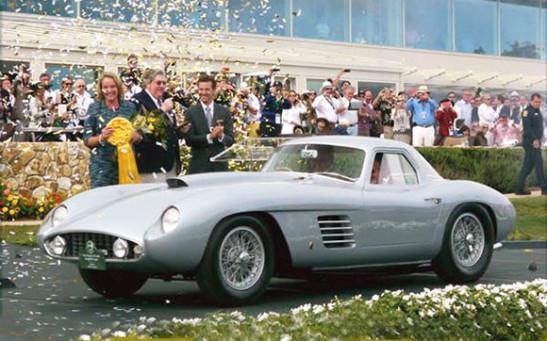
1954 Ferrari 375 MM Scaglietti Coupe, ex-Rossellini, celebrates its Best of Show at the 2014 Pebble Beach Concours d’Elegance. Image from auto.ferrari.com..
Another good story comes with the 2014 Pebble Beach Concours-winning 1954 Ferrari 375 MM Scaglietti Coupe. Being the first Ferrari to be honoured with Pebble’s Best of Show is true. Being ex-Rossellini is also legit.
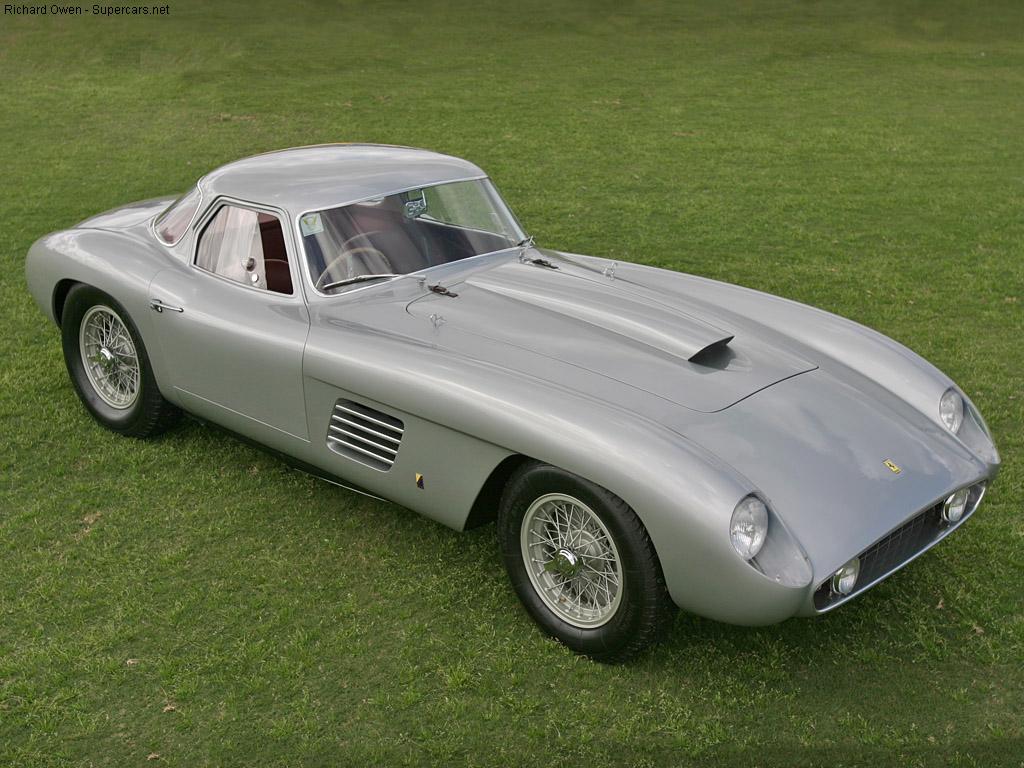
According to barchetta.cc, on August 21, 1954, Rossellini paid 4 million Lire (about $6400 back then, perhaps $57,000 in today’s dollar) for a red 375 MM Spyder.
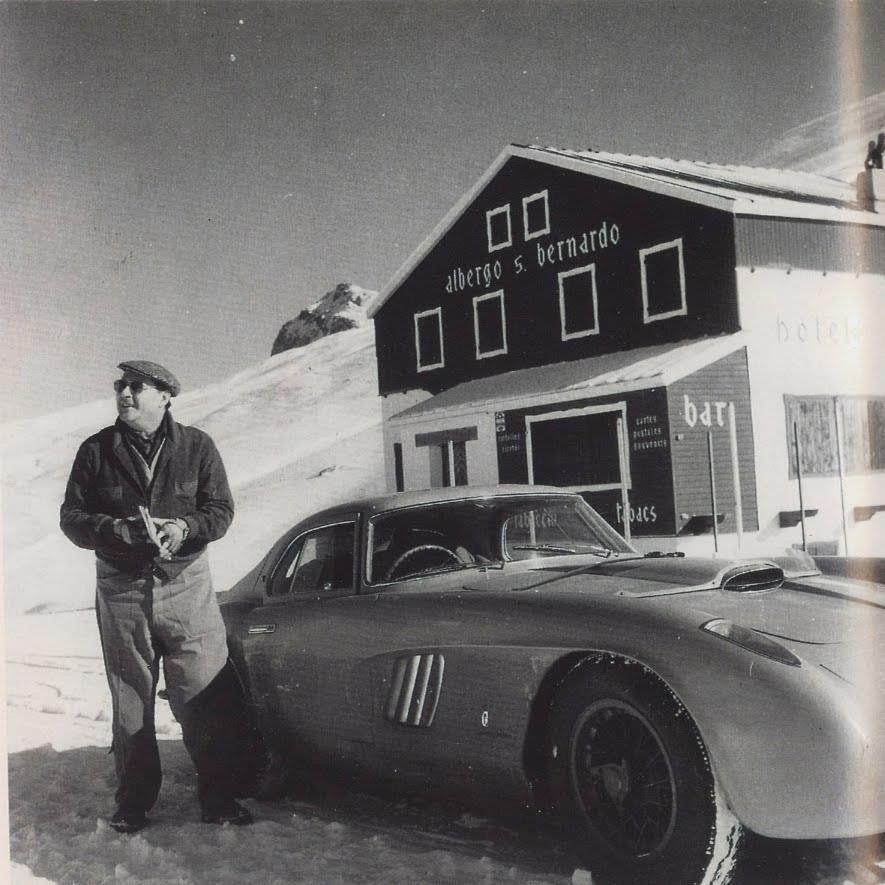
This is 1954 Ferrari 375 MM s/n 0456AM. The location is the Little St. Bernhard Pass, just few meters from the Italy-France border. The person is Roberto Rossellini, who owned this car 1955 – 1957, on the 1st March 1955.
Continuing its history, supercars.net reports that the car returned to the works in 1955, after an accident that seriously damaged its front end. It was then that Scaglietti rebodied the Rossellini 375 MM as a coupe, in silver paintwork and with front fender contours anticipating the Ferrari 250 Testa Rossa to be introduced in 1957.
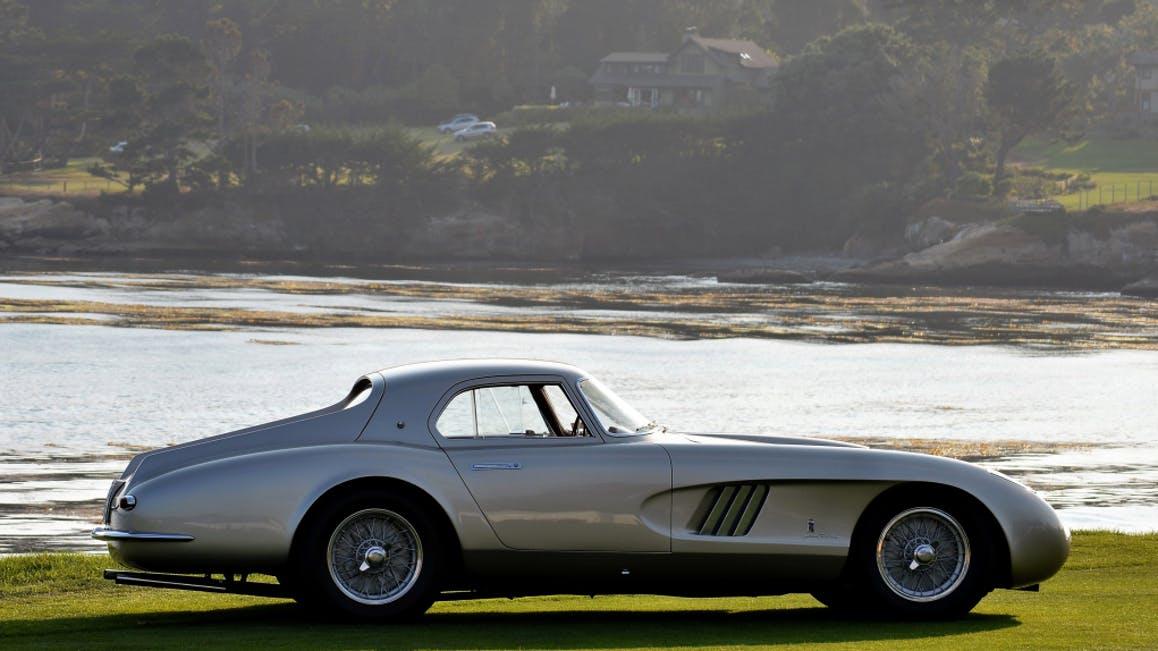
Credit: Wheelsage.
In 1953, Ferrari presented a car that would rule the World Sportscar Championship series. The 375 MM was not only gorgeous to look at, but was also Prancing Horse’s ultimate weapon. But, as it is with many Ferraris, it caught the eyes of many rich people wanting to own this beauty. The company then decided to convert only 5 units to be road-going versions, which would be sold to customers approved only by Enzo himself.
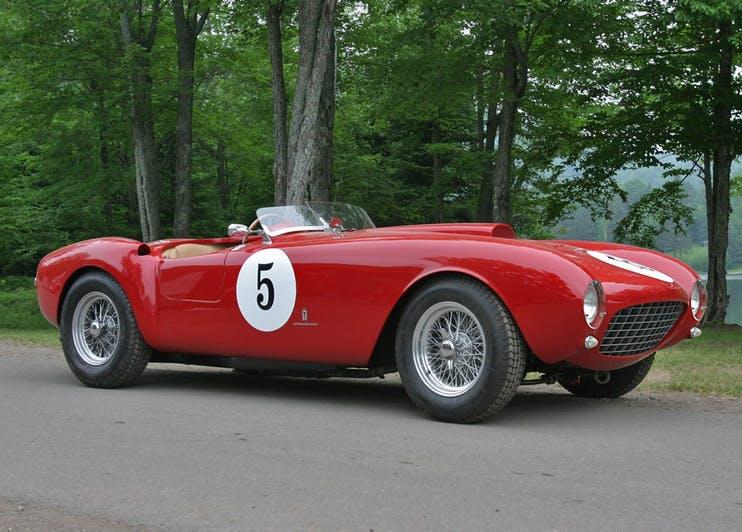
375 MM Spyder. Credit: Supercars.net
The road versions were given the word ‘Speciale’ to their name and, probably, the most notable one is the chassis #0456AM. This unit was commissioned by Roberto Rossellini as a wedding present for his wife, famous actress Ingrid Bergman.
First revealed at the 1954 Paris Motor Show, the 375 MM Bergman Coupé featured a one-off body designed by Pininfarina. Apart from the rotating headlights and the fins on the rear fenders, another interesting detail are the huge cut-outs behind the front wheels.
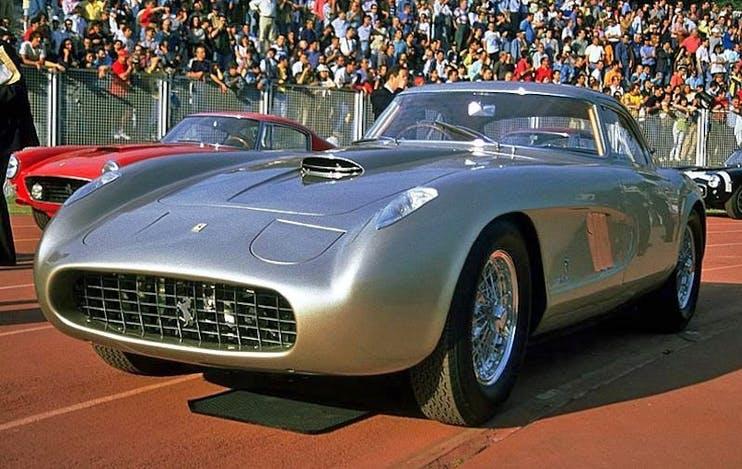
Credit: My Car Quest.
After the presentation in Paris, the car was delivered to Rossellini, who gifted it to his beautiful wife.
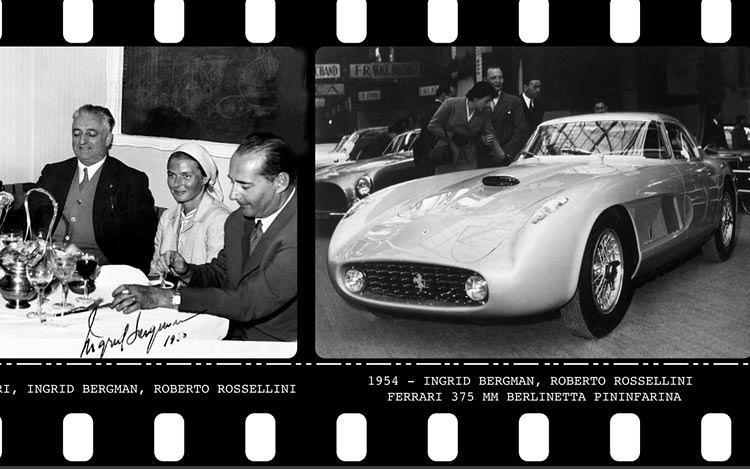
Enzo Ferrari, Ingrid Bergman and Roberto Rossellini.
Ingrid Bergman, Roberto Rossellini and a Ferrari 375 MM Berlinetta Pininfarina in 1954.
However, the story has fascinating variations. Some report that she didn’t accept it because, apparently, she didn’t like the way it looked. Others say Bergman complained because the car’s original barchetta (open) coachwork mussed her hair, thus the Scaglietti conversion into a coupe. So, Rossellini decided that he will keep and drive the car (after all, he paid for it).
Being an avid car collector, Rossellini commissioned another custom 375. After he crashed a racing version of his 375 MM Spyder, he called Scaglietti to design a new coupe body for it. The new design was made to resemble a Mercedes 300SL “Gullwing” and, just like the 375 Bergman Coupé, this one featured a 330 HP V12 engine under the bonnet. It was still very fast, very sporty and unique, but its presence was no match to its Pininfarina sibling.
This 375 MM Speciale Bergman Coupé was a part of Rossellini’s collection for some time until he sold it to a customer in the United States. After some time, the car was purchased by the Microsoft executive Jon Shirley. He restored the car completely and gave it a new and fresh layer of the same original colour “Grigio Ingrid”.
Today, the car’s whereabouts are unknown; some sources speculate that Shirley still has it. Nevertheless, I’m sure we can agree that this Prancing Horse is a masterpiece. The 375 MM Bergman Coupé later inspired the design of the 1956 Corvette as well as the Ferrari 612 Scaglietti in 2004.
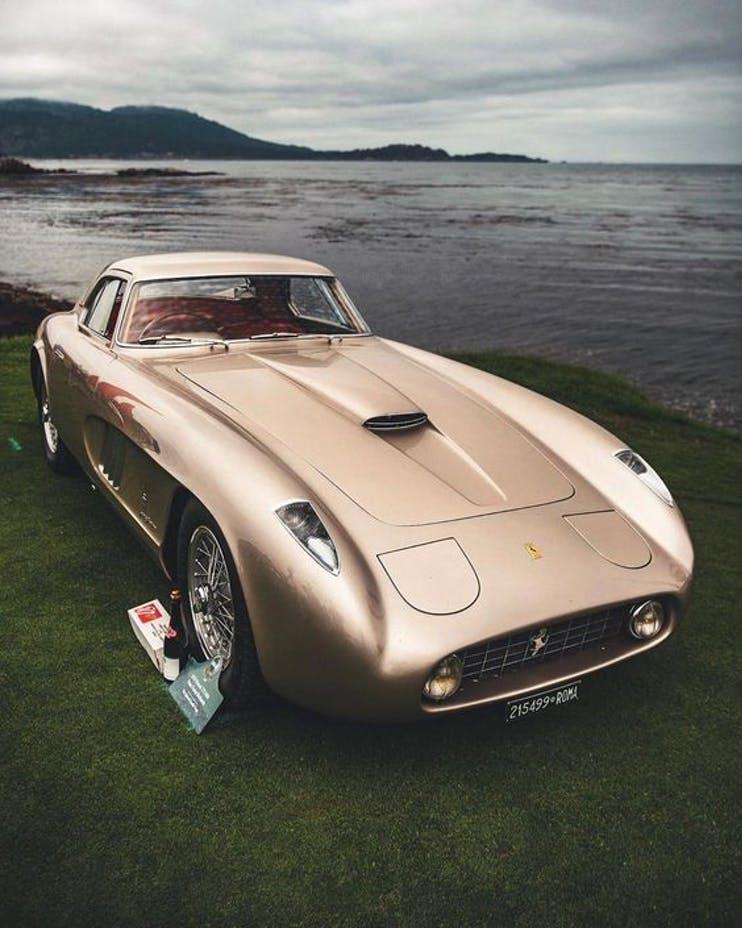
Credit: Wheelsage
There is no denying that the nickname “Dono d’amore” (Gift of love) really suits this car. Even though Ingrid didn’t like the car, the Ferrari 375 MM Speciale Bergman Coupé is quite a lovely sight to behold … just like the actress herself.
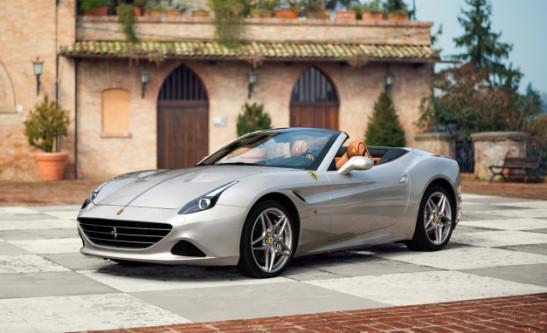
2015 Ferrari California T, as exhibited at Shanghai 2015. Image from caranddriver.com.
At Auto Shanghai 2015, Ferrari showed a California T said to be inspired by Ingrid Bergman and Jackie Kennedy. Its exterior is “Grigio Ingrid,” its leather-covered seats pay homage to the “Kennedee chair” designed for Jackie Kennedy by Jean-Marie Massaud in 1961.
Snapshot, 1982: Roberto Rossellini bids farewell to Princess Grace. 19 April 2018.
It’s 18 September 1982 and the world’s mourning the loss of Grace Kelly, former Hollywood actress and princess of Monaco. Passing on his late parents’ regards — Italian filmmaker Roberto Rossellini and Swedish actress Ingrid Bergman — Roberto Ingmar Rossellini arrives at the funeral in his Ferrari…
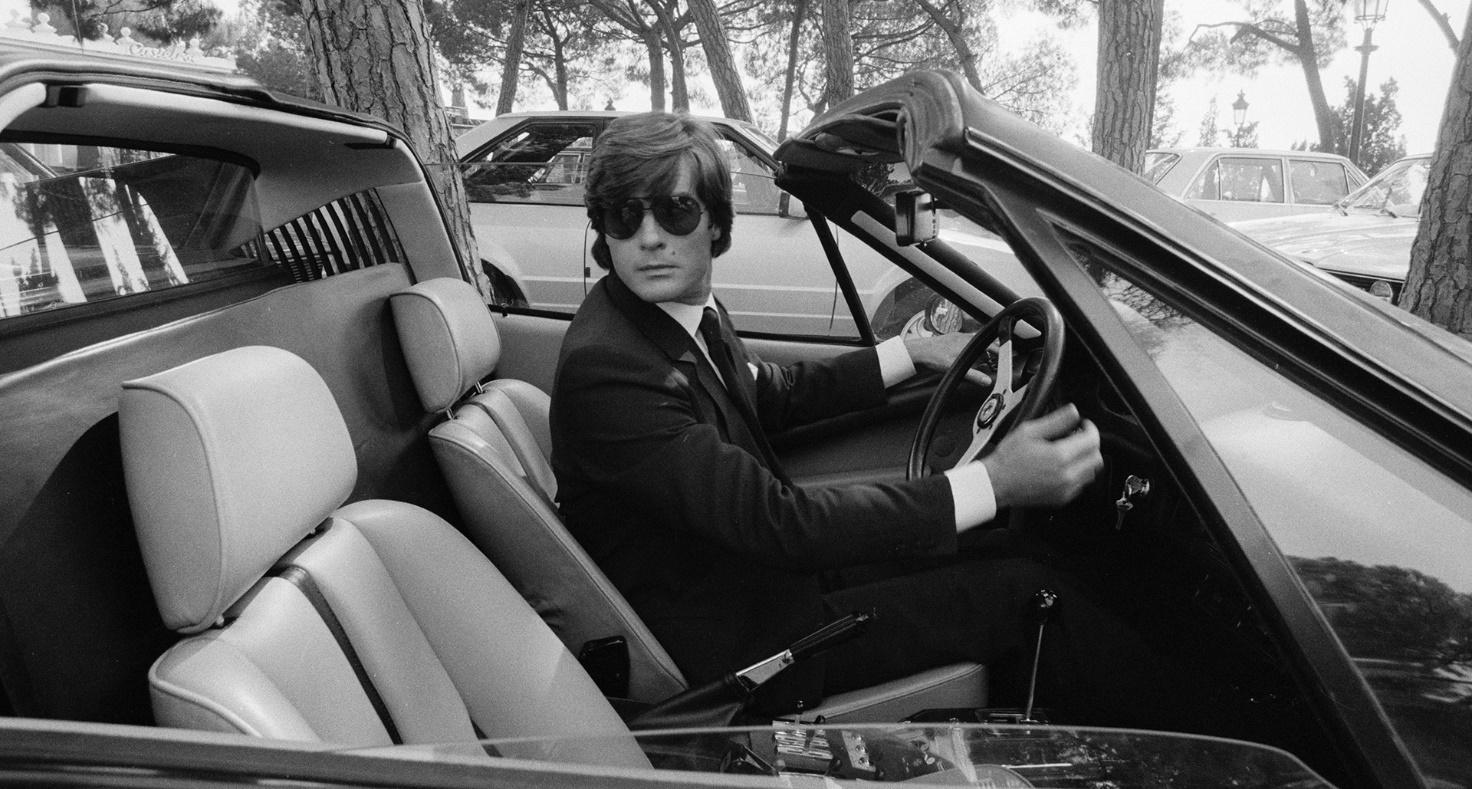
Photo: Daniel Simon / Gamma-Rapho via Getty Images.
Following a sombre procession that made its way from the family palace to the Saint Nicholas Cathedral, the world stopped for a few hours to say its final goodbyes to the lovely and endearing Grace Kelly. As evidence of the admiration and respect that both Hollywood and heads of state had for Princess Grace, over 400 people were in attendance, including Princess Diana of Wales, French Foreign Minister Claude Cheysson, Cary Grant, Jackie Stewart and Roberto Rossellini. Actor James Stewart performed the eulogy, saying, “Grace brought into my life, as she brought into yours, a soft, warm light every time I saw her and every time I saw her was a holiday of its own.” Farewell, fair princess.
Videos
Roberto Rossellini
Ingrid Bergman

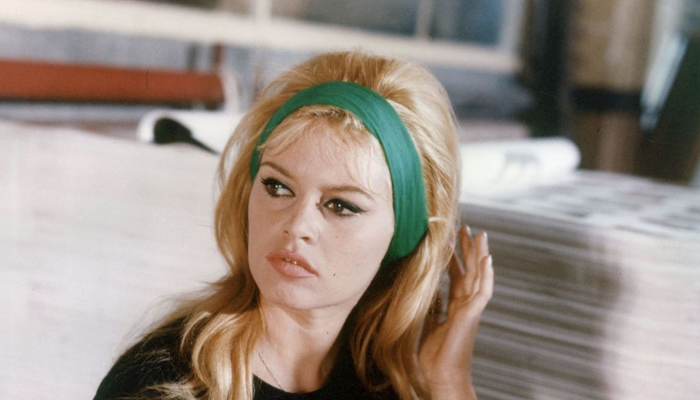
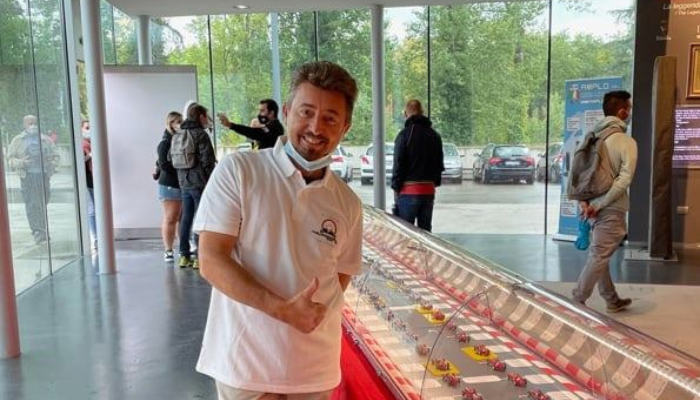
Comments
Authorize to comment